
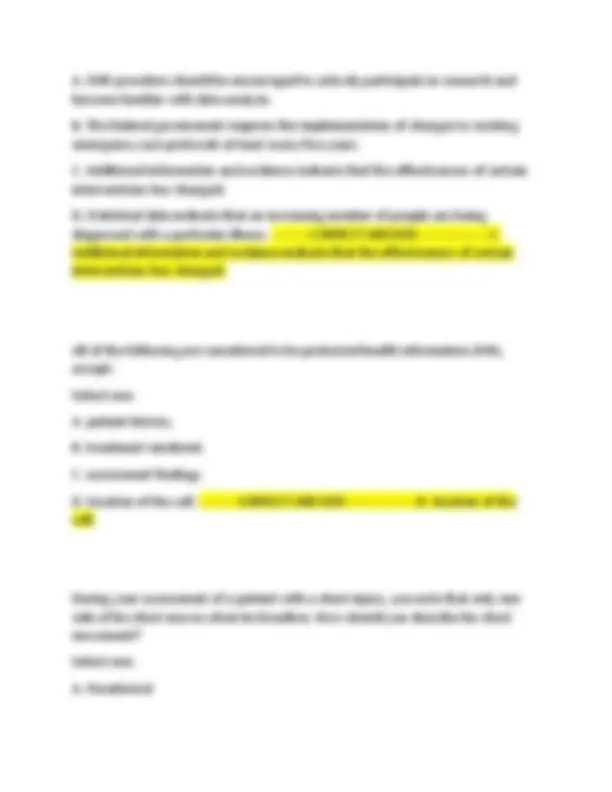
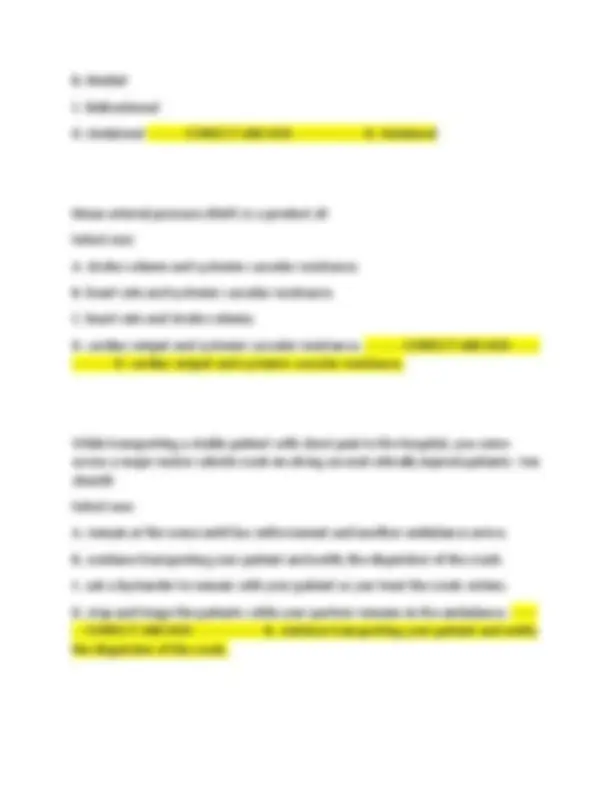
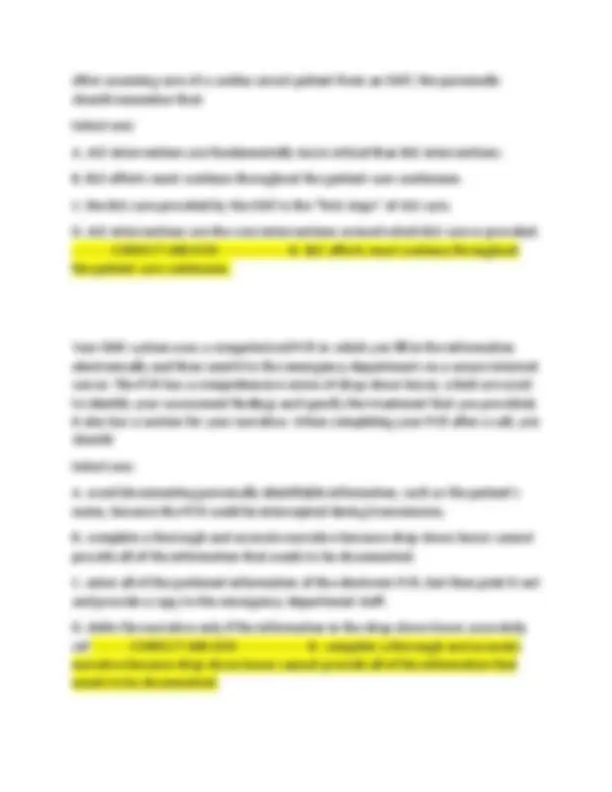
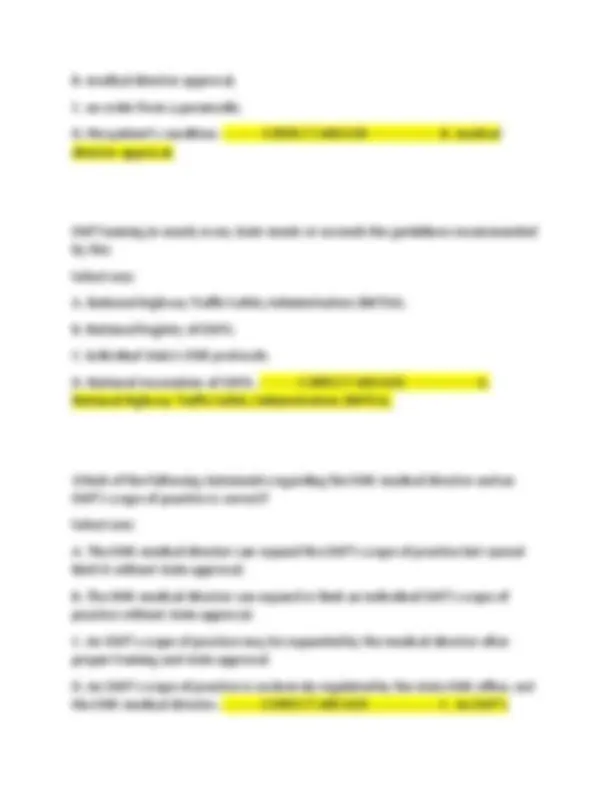
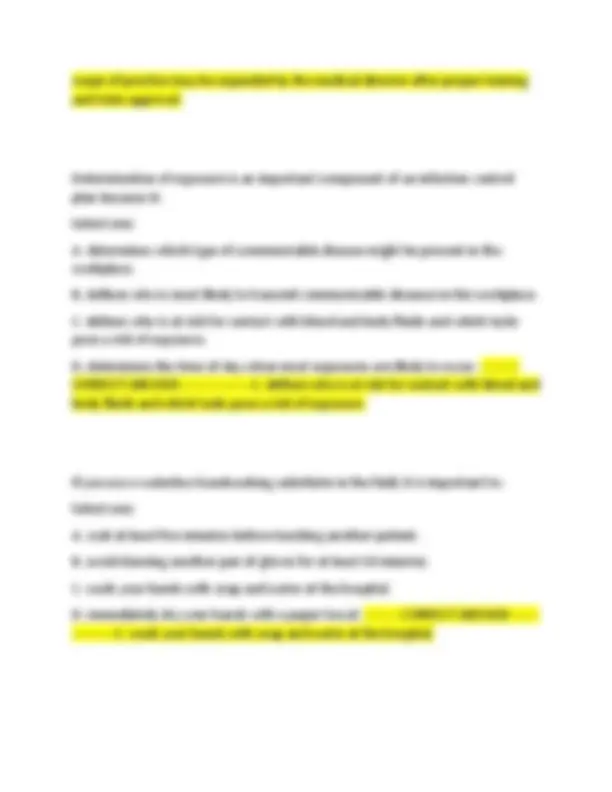
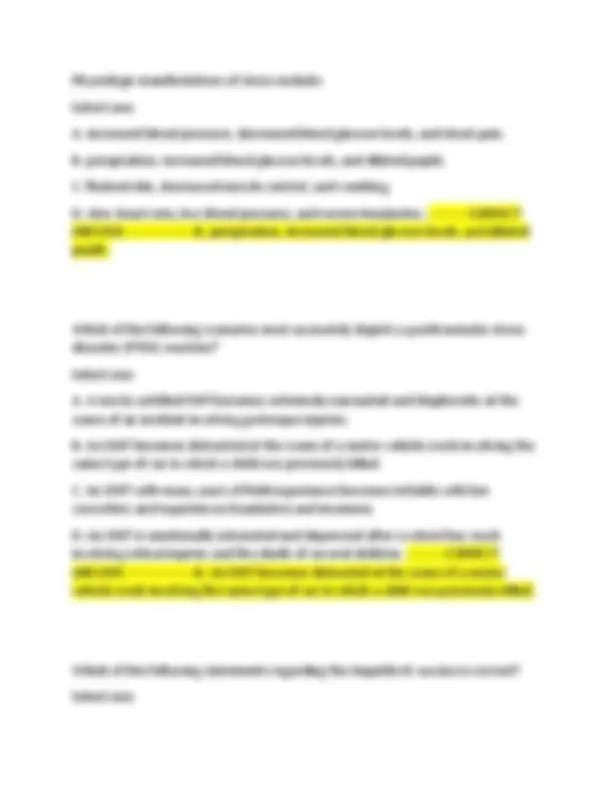
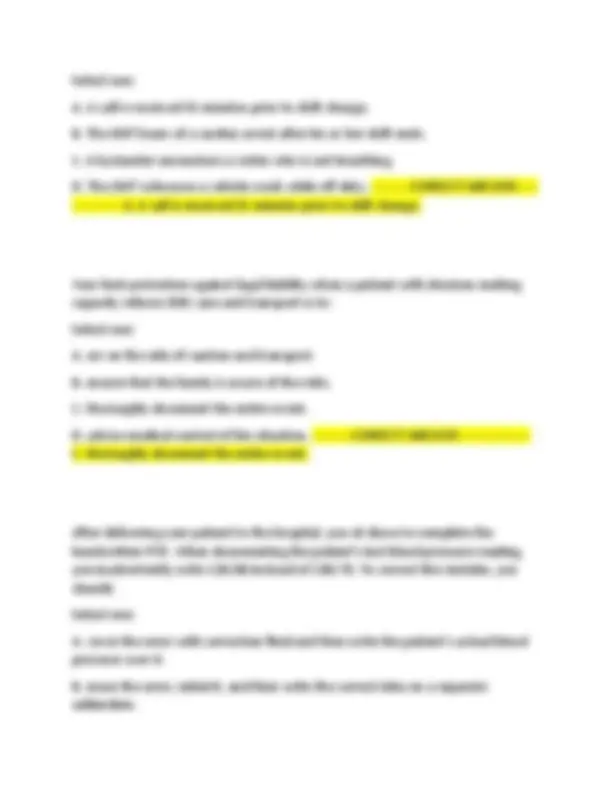
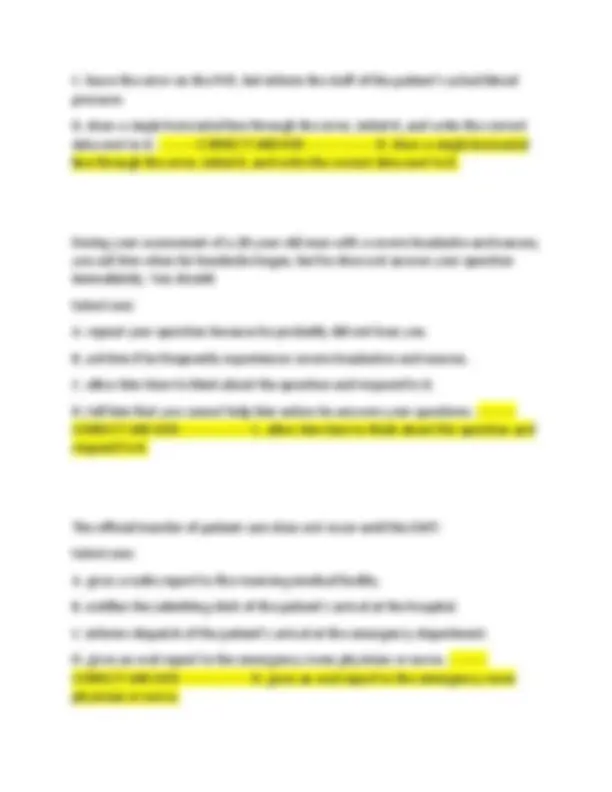
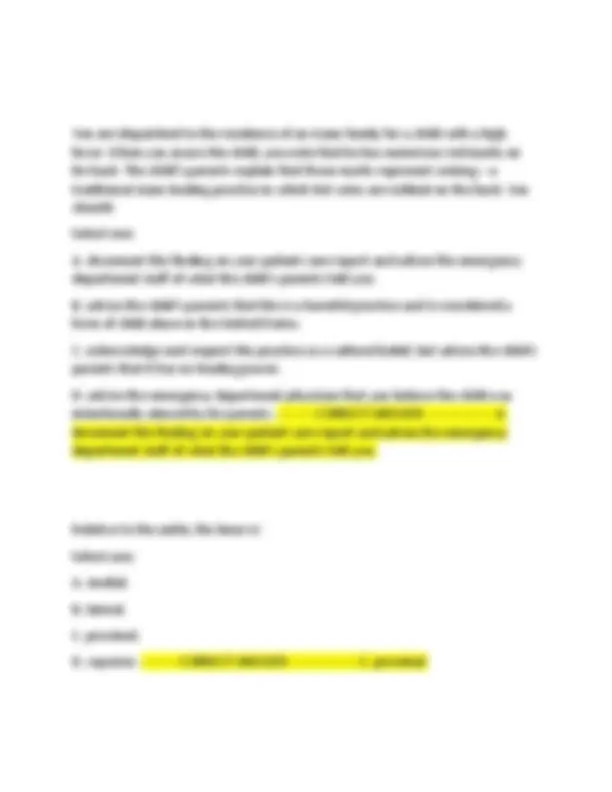
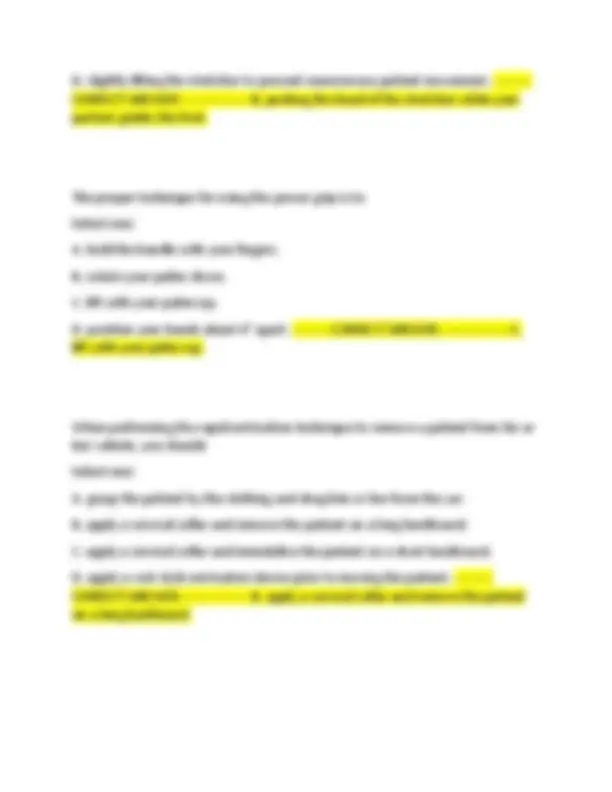
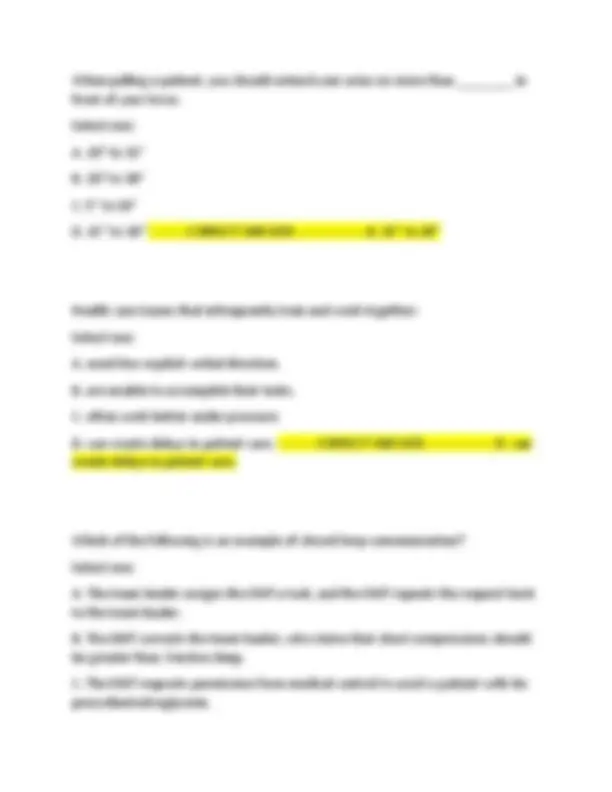
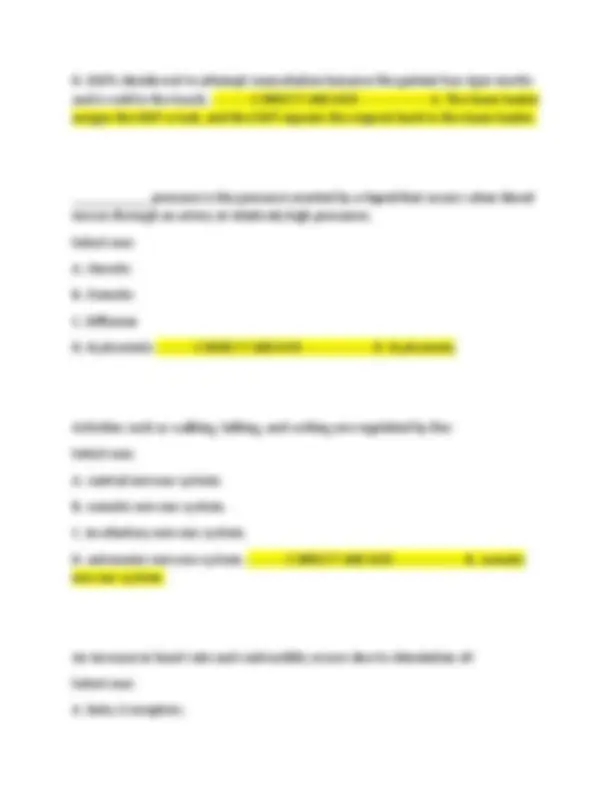
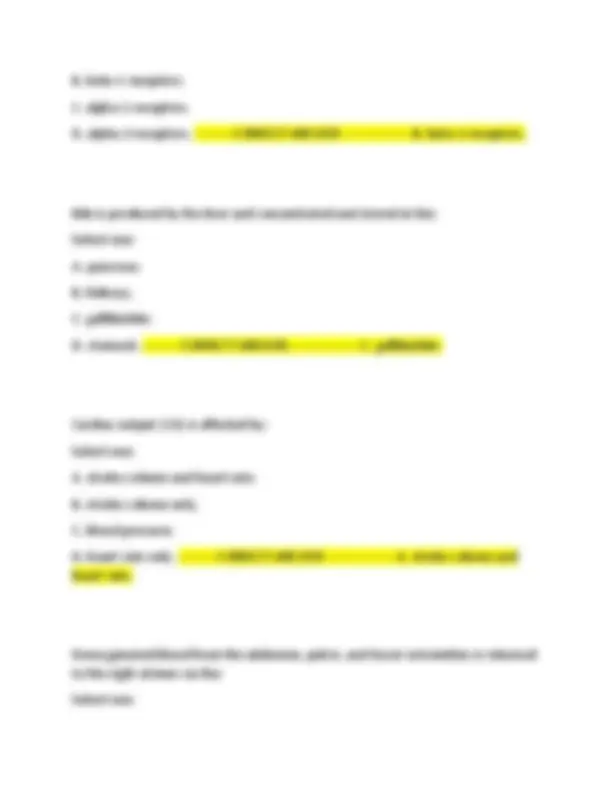
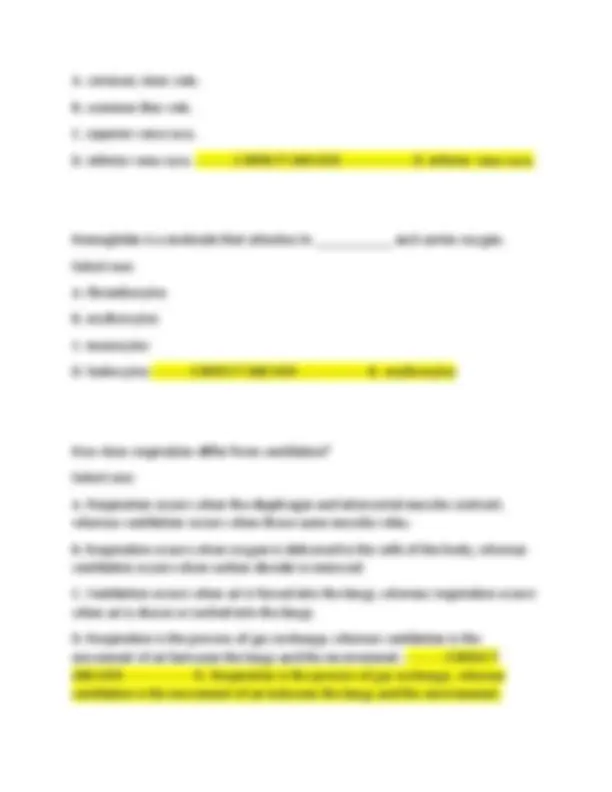
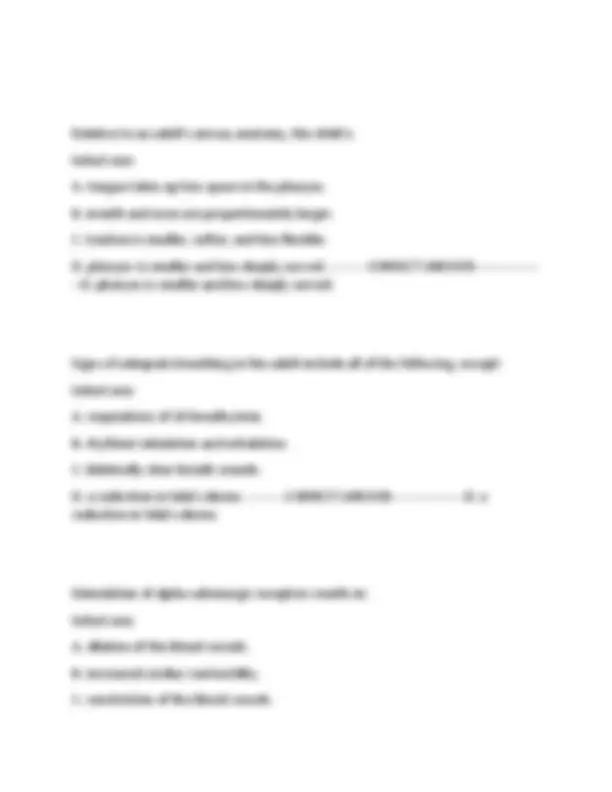
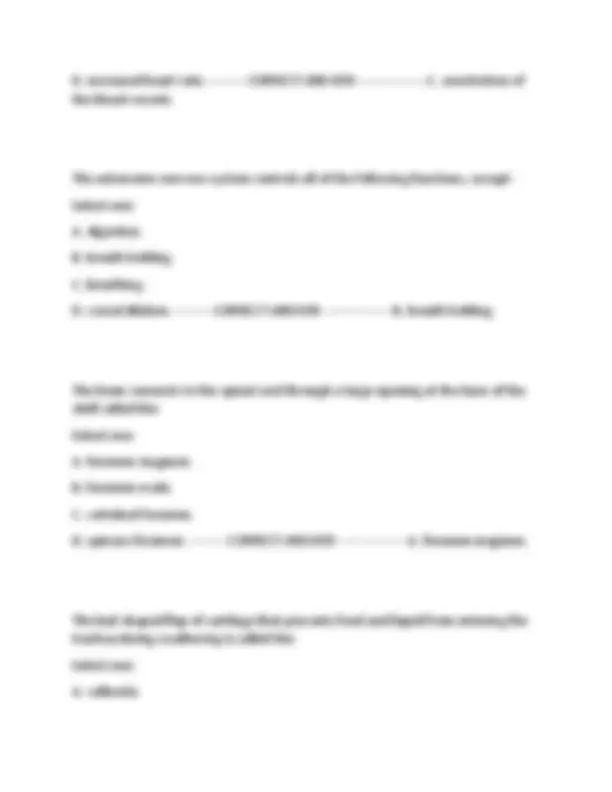
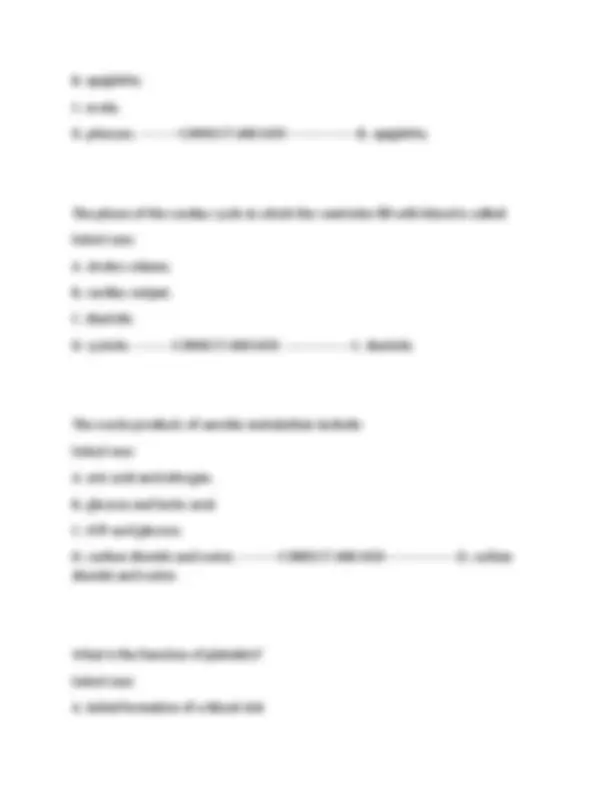
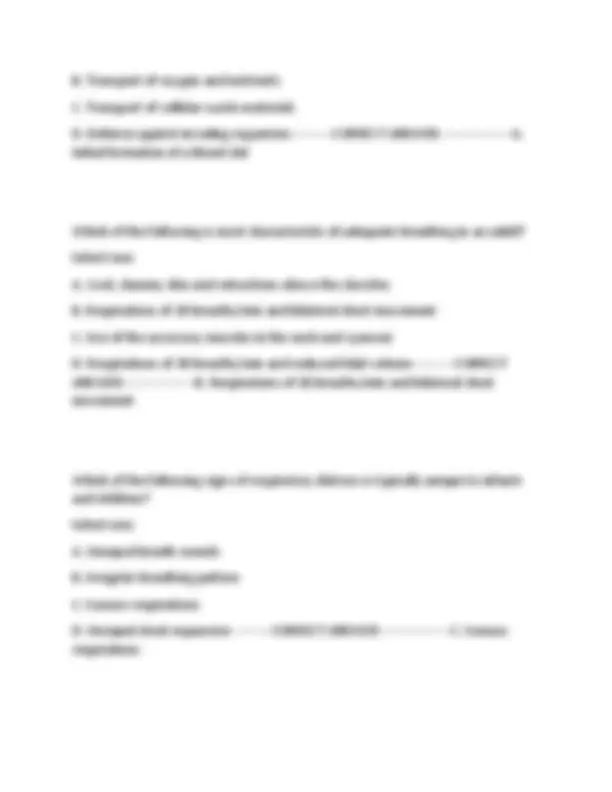
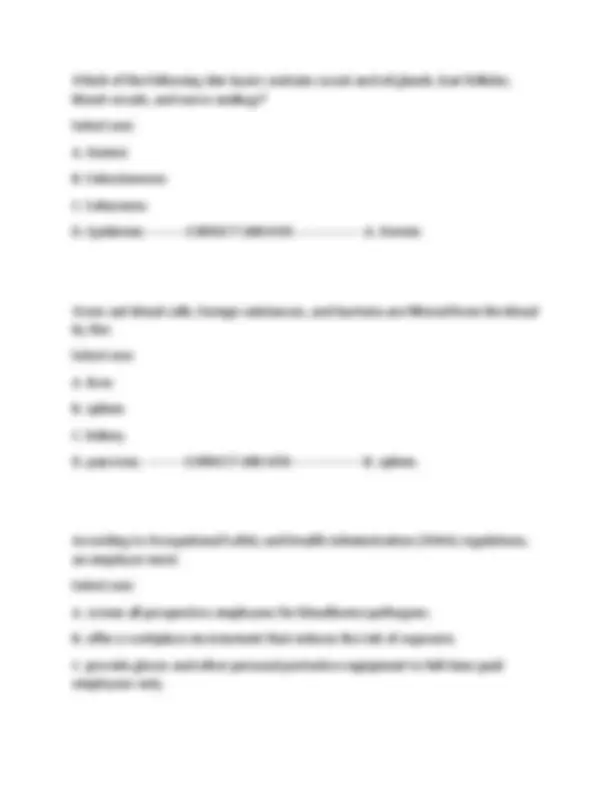
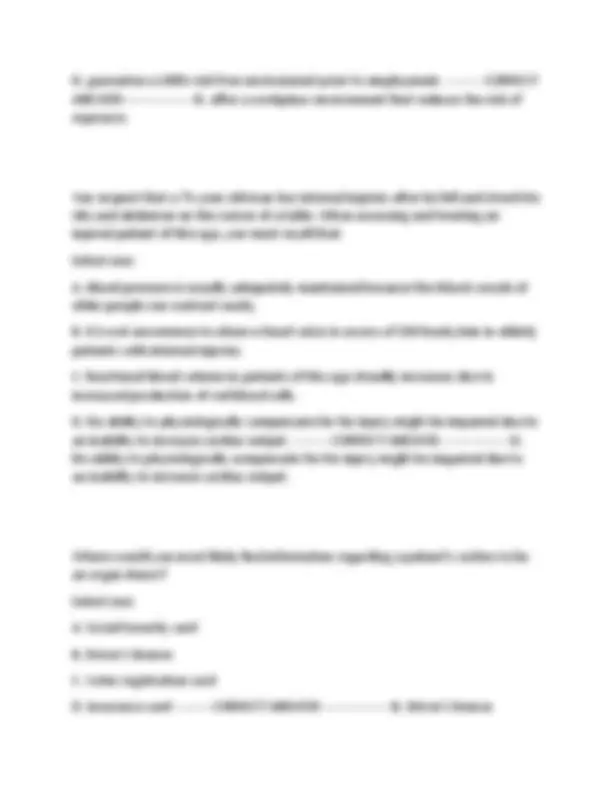
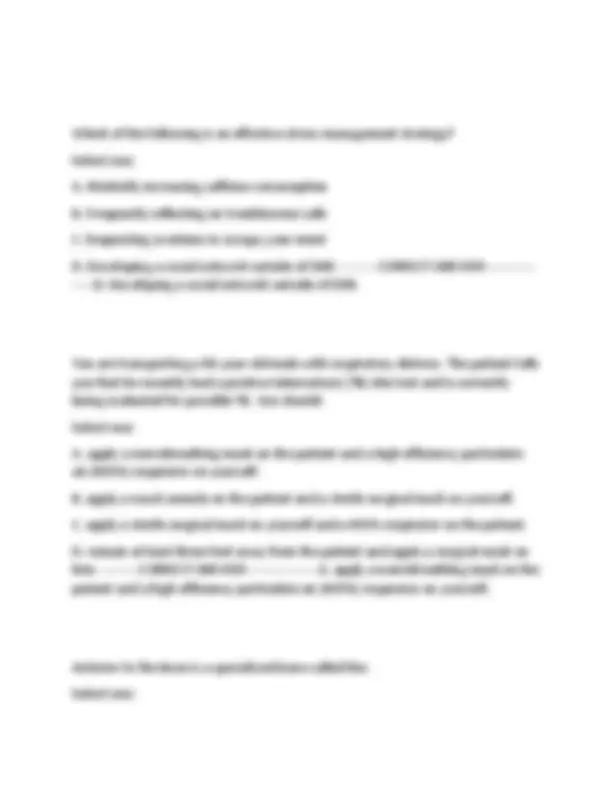
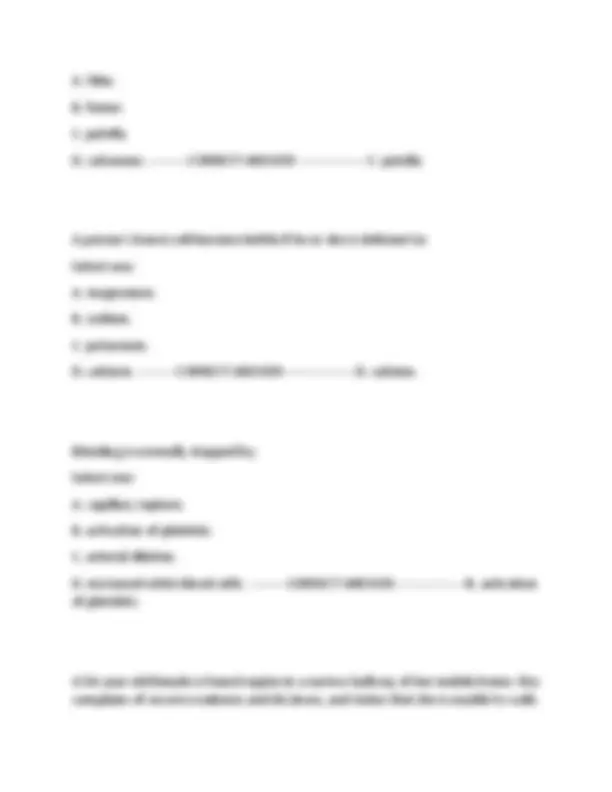
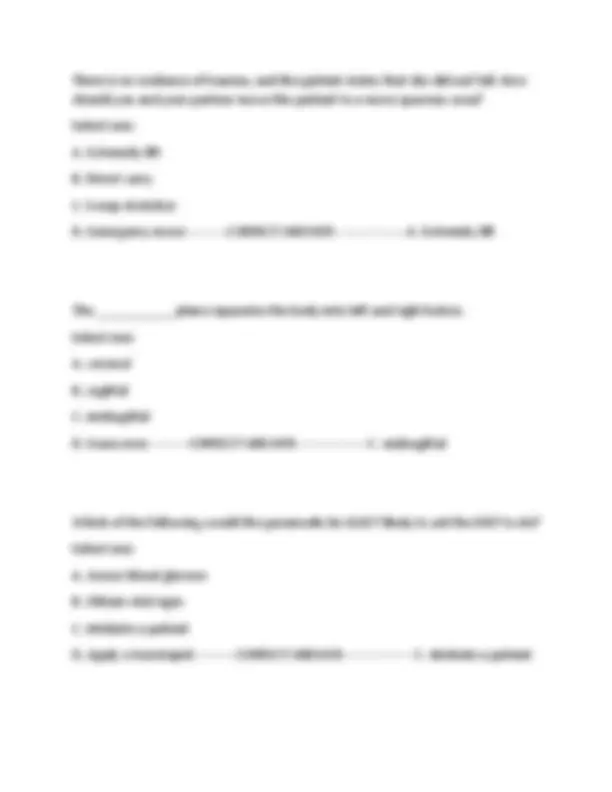
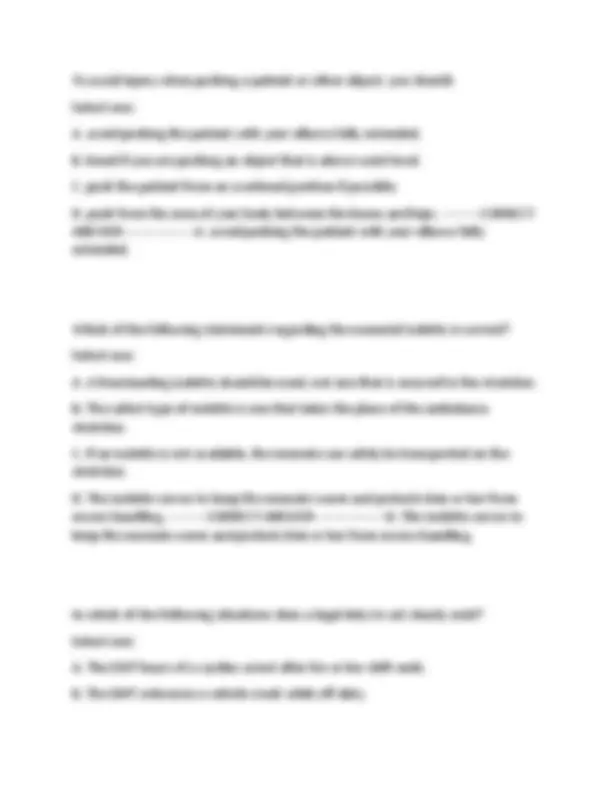
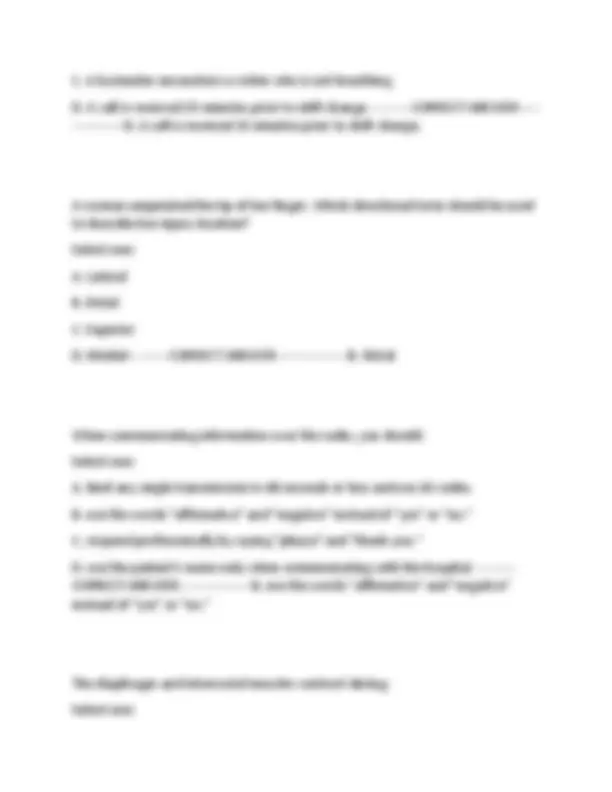
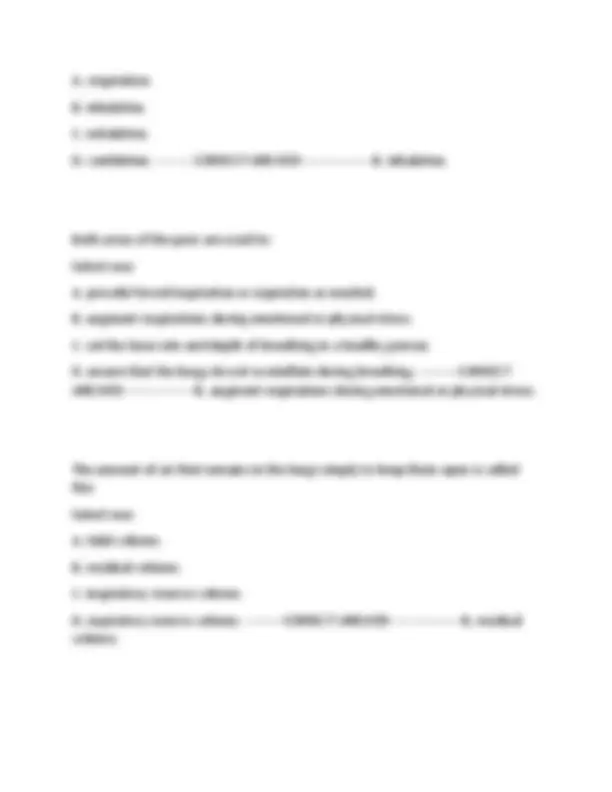
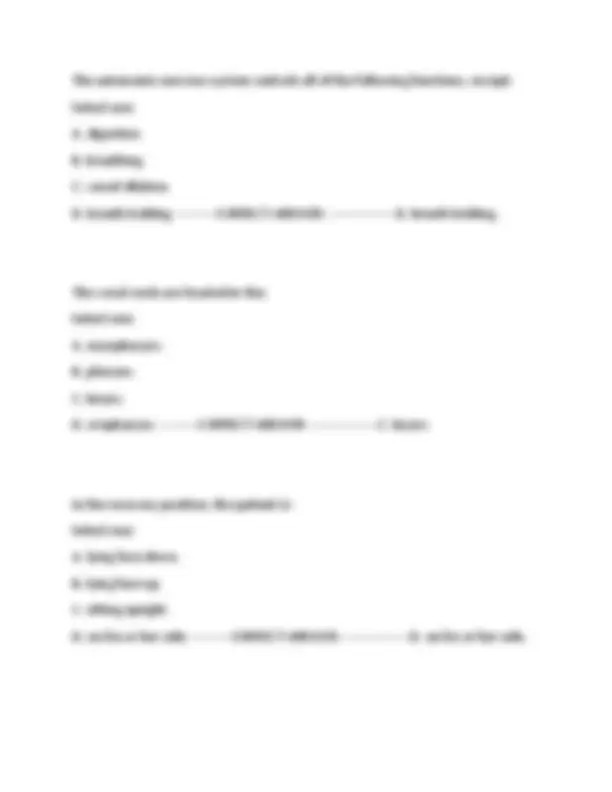
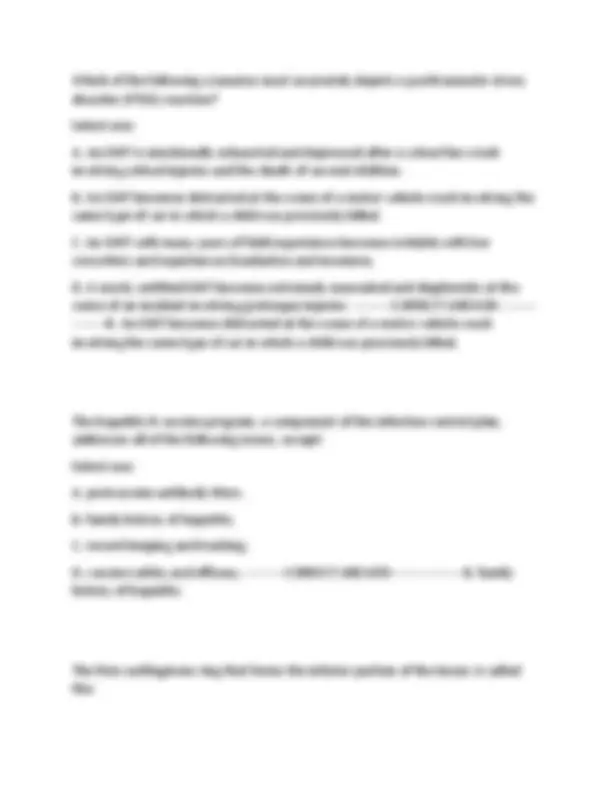
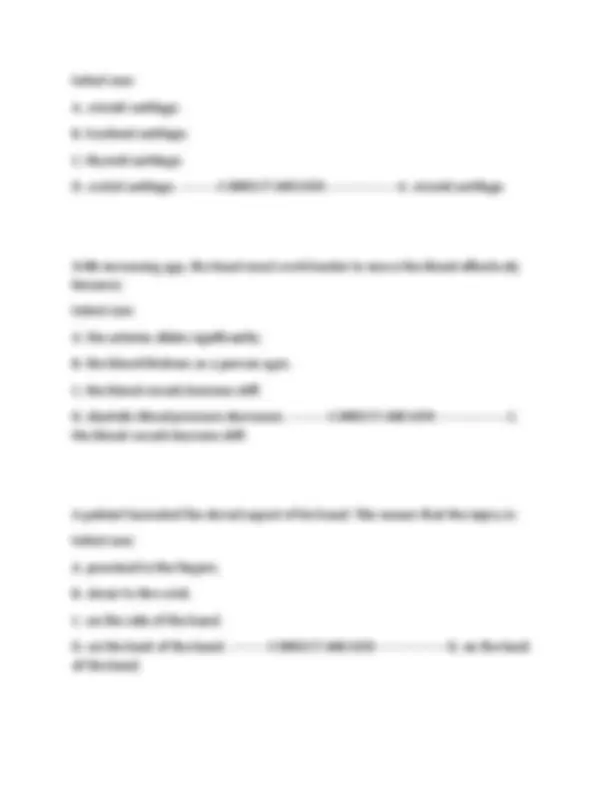
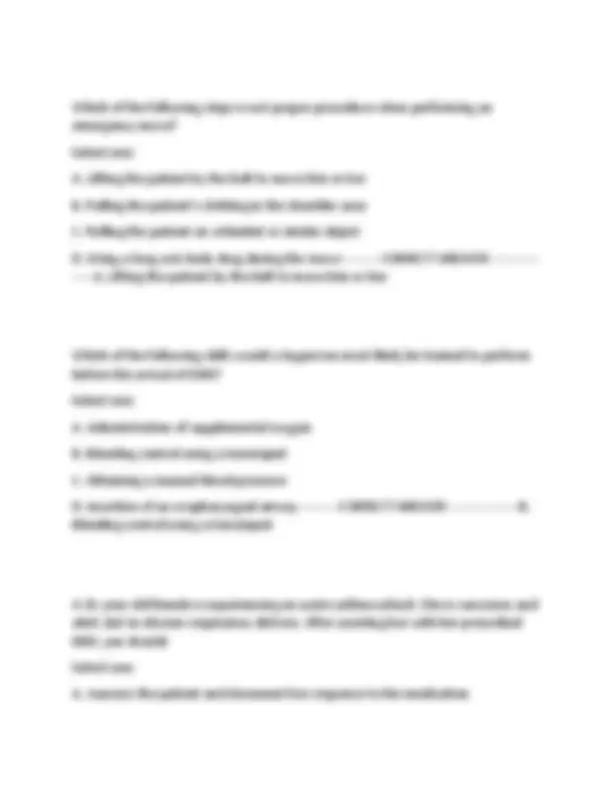
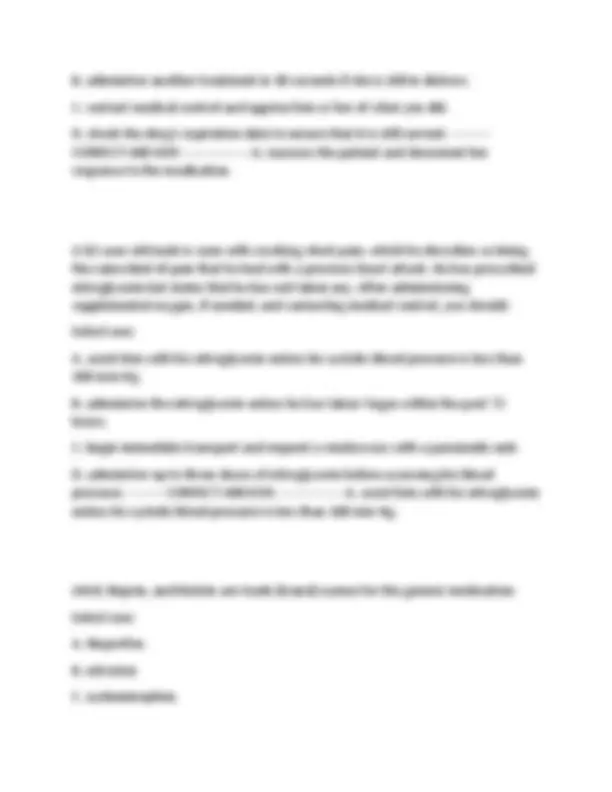
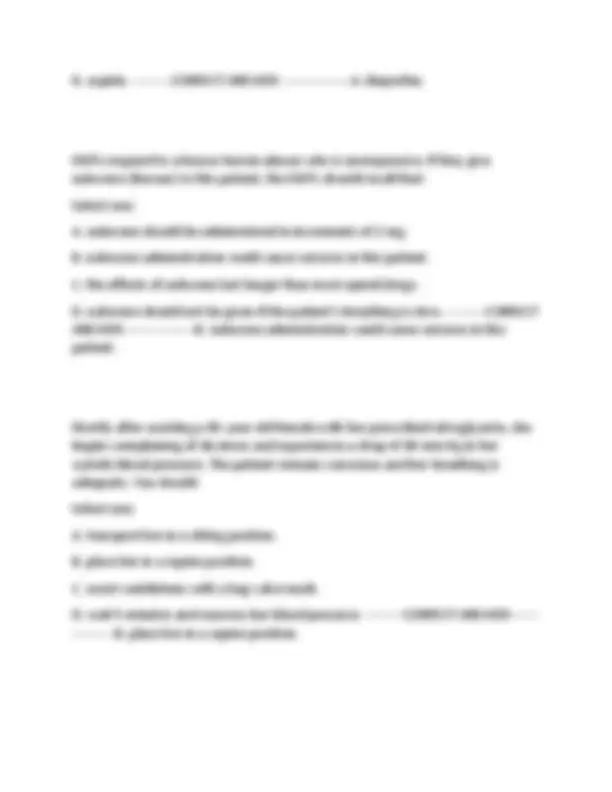
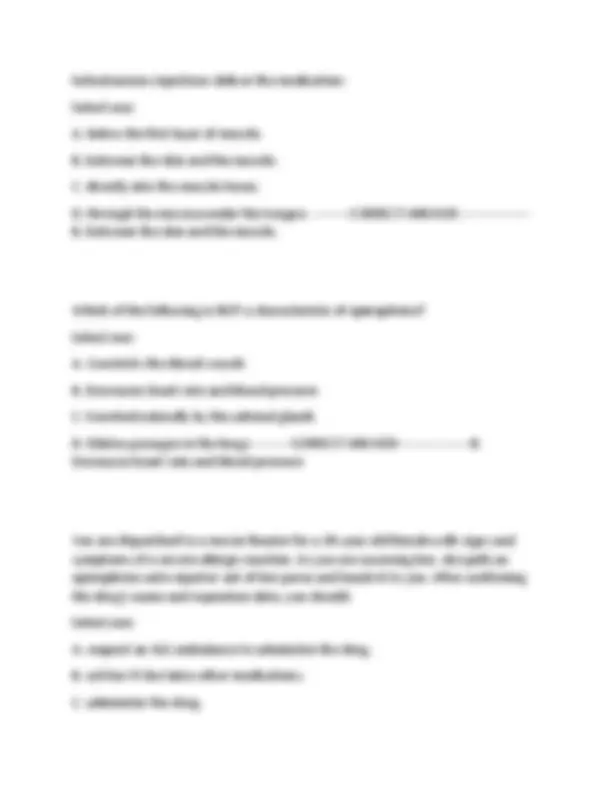
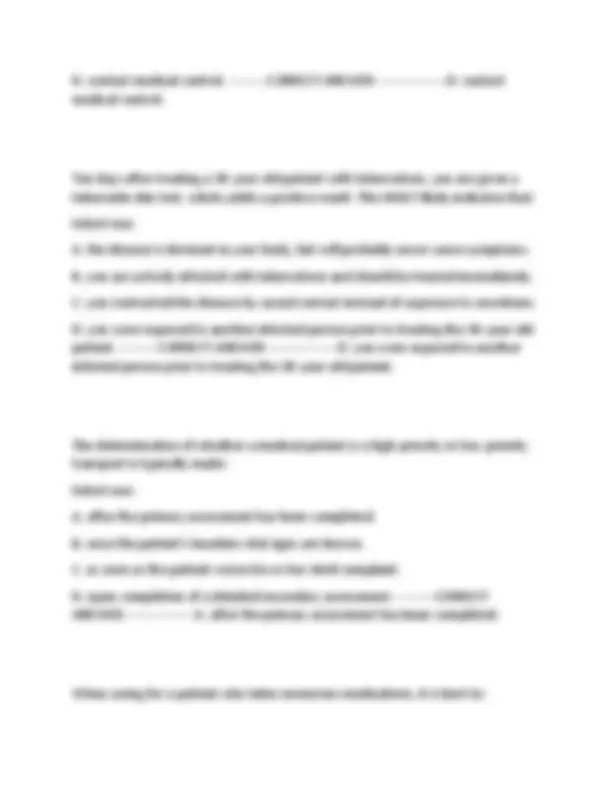
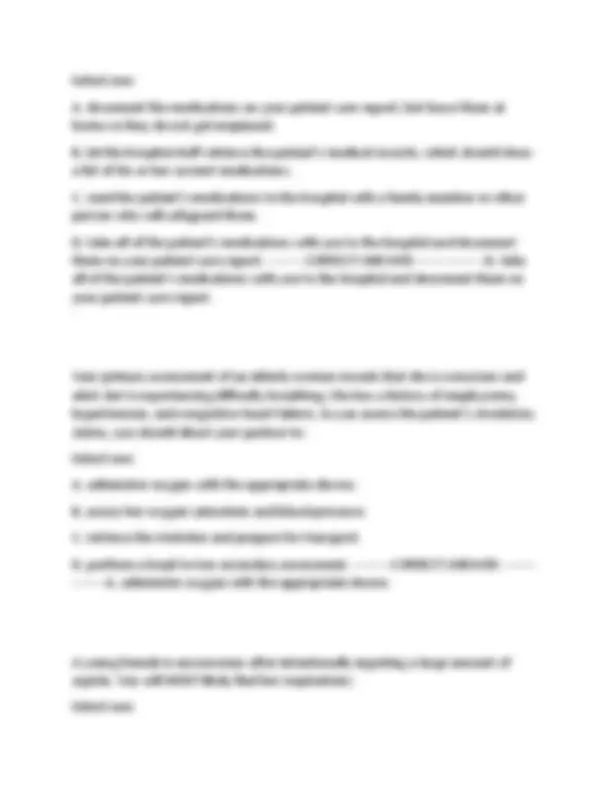
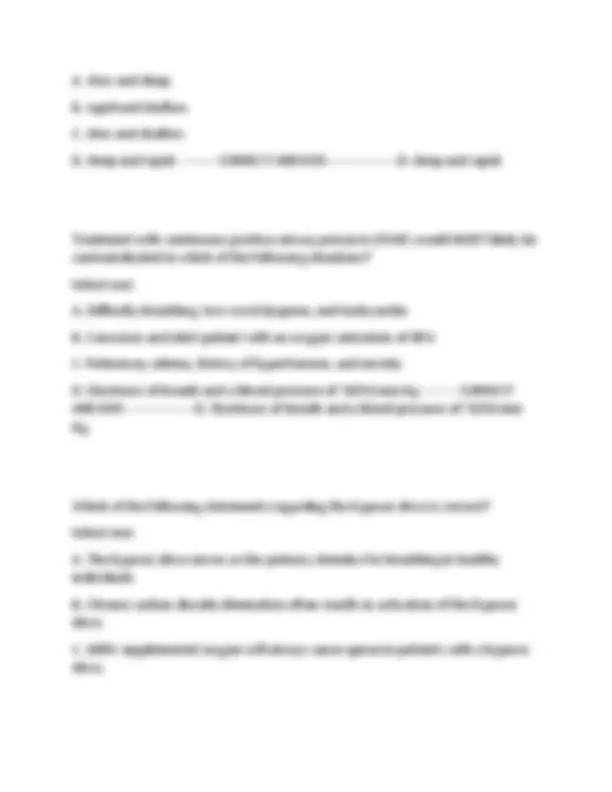
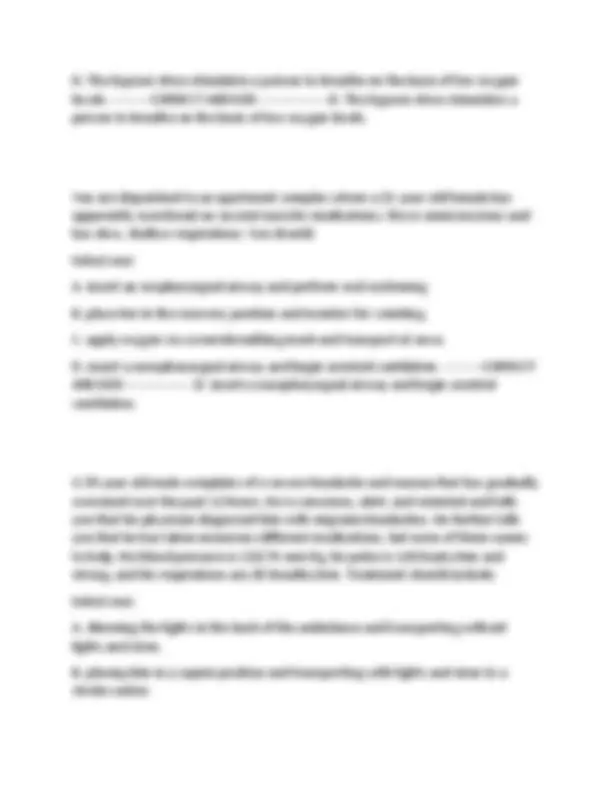
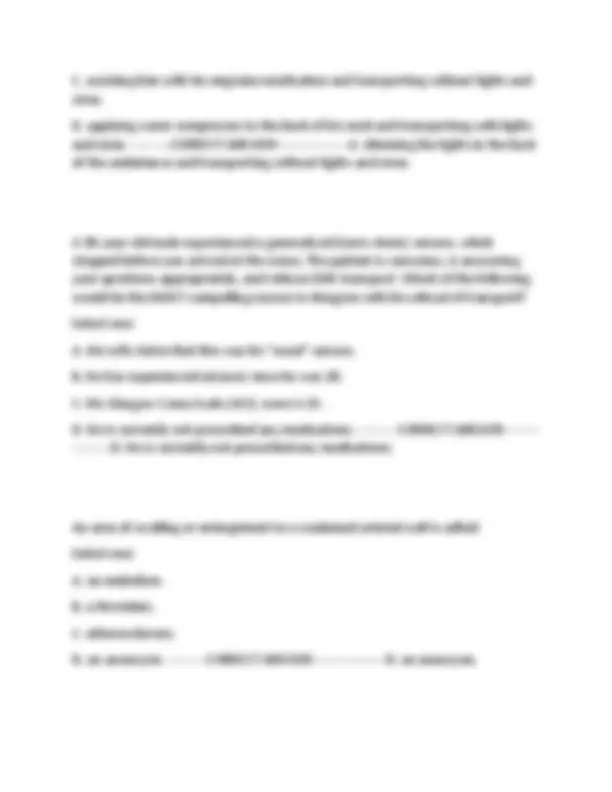
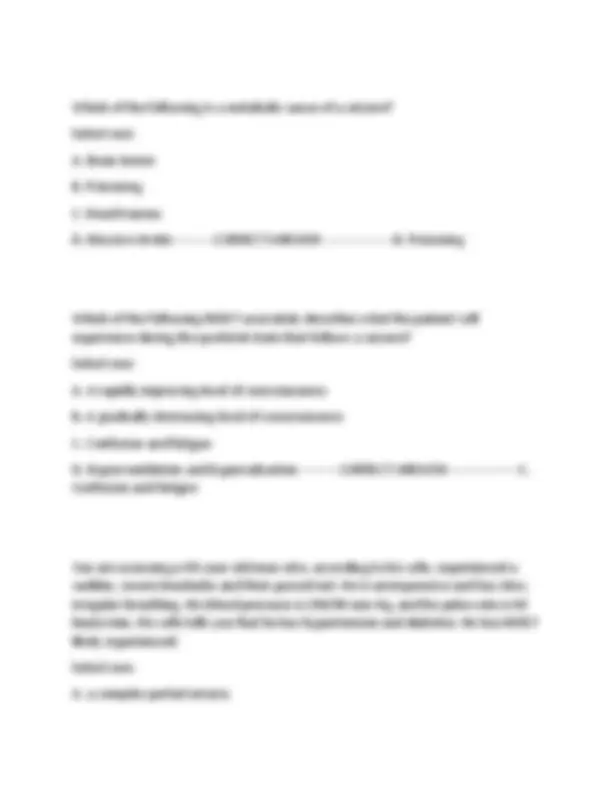
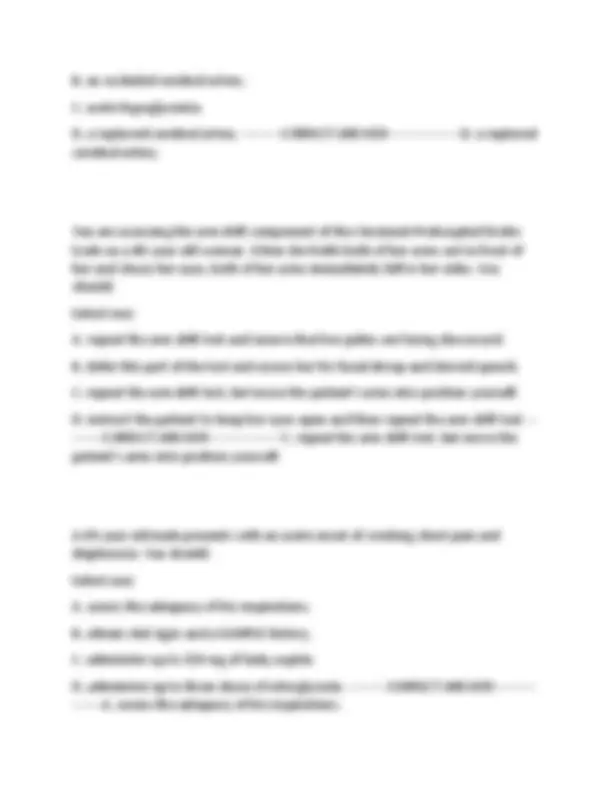
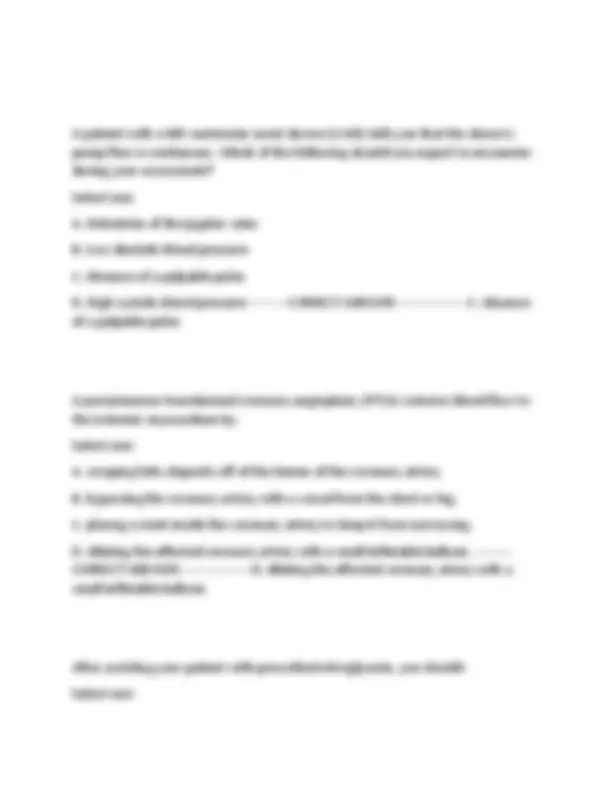
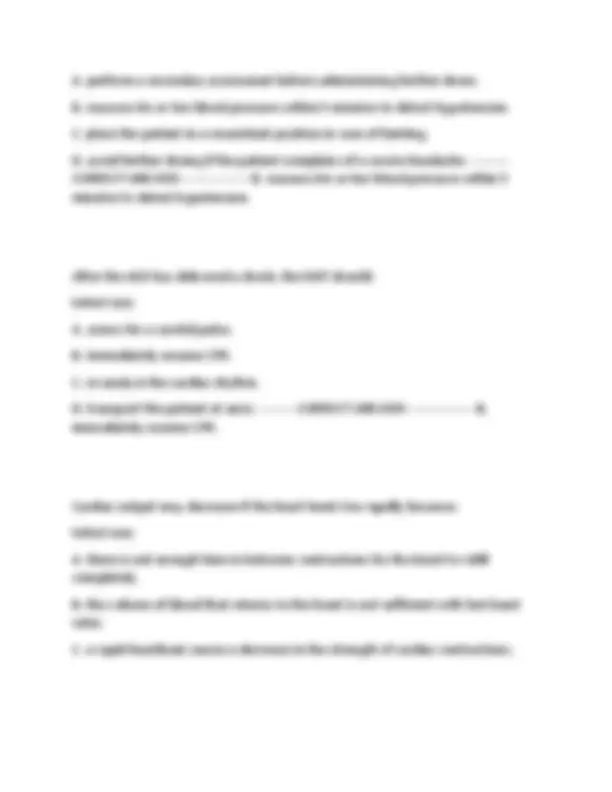

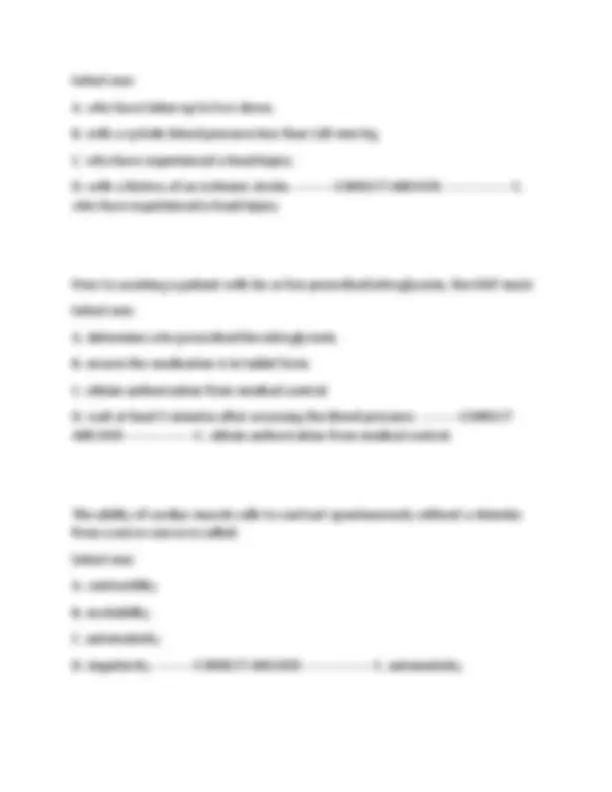
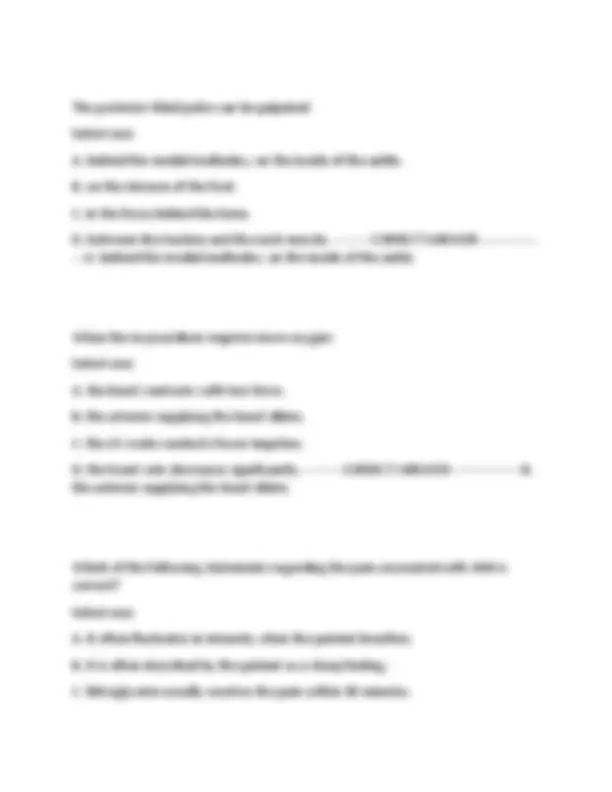
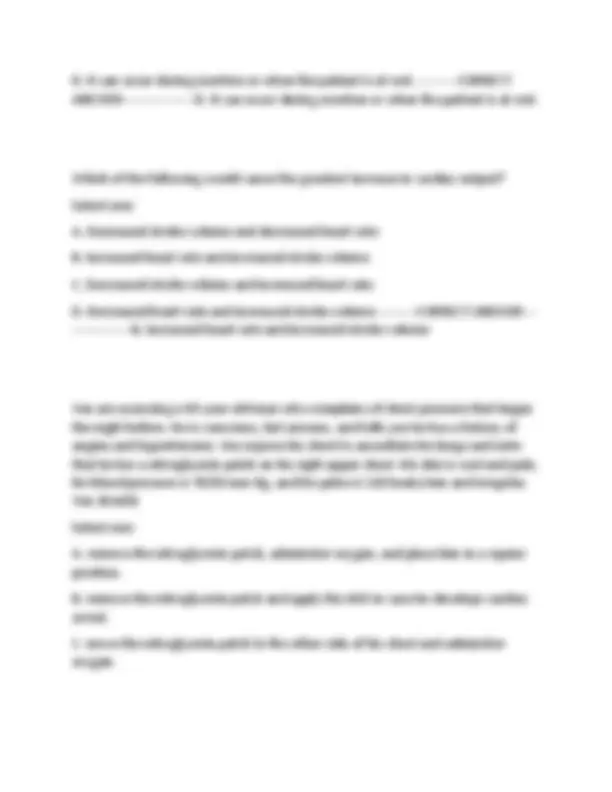
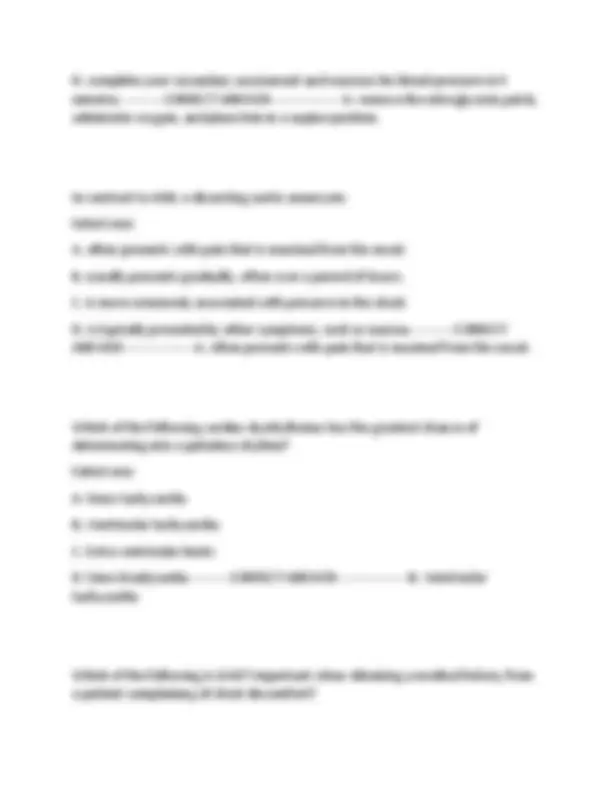
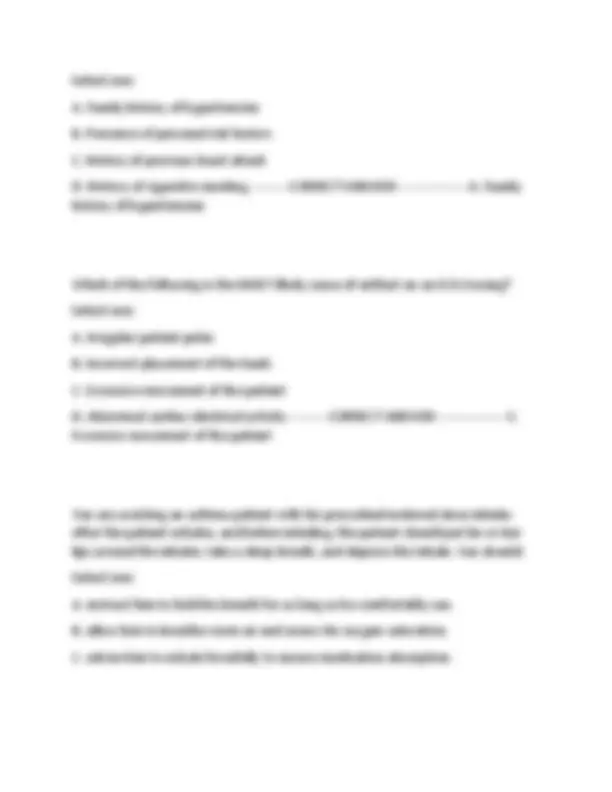
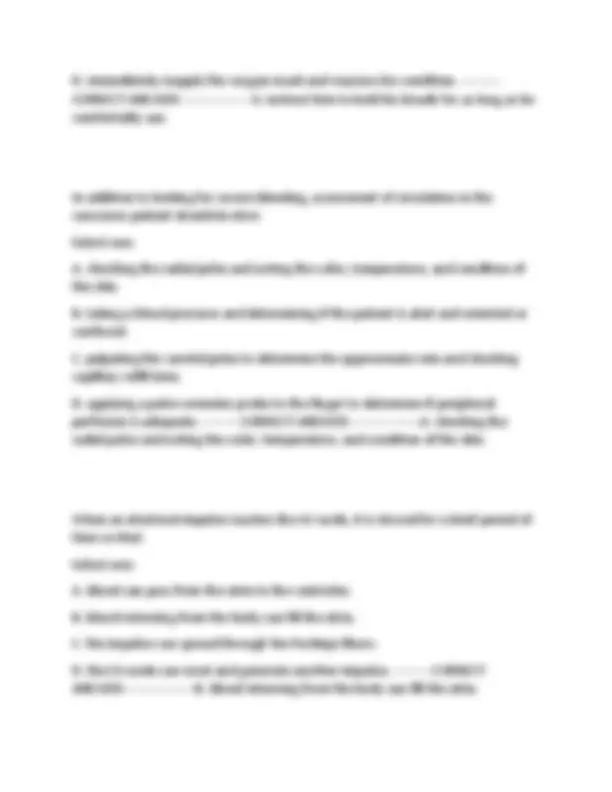
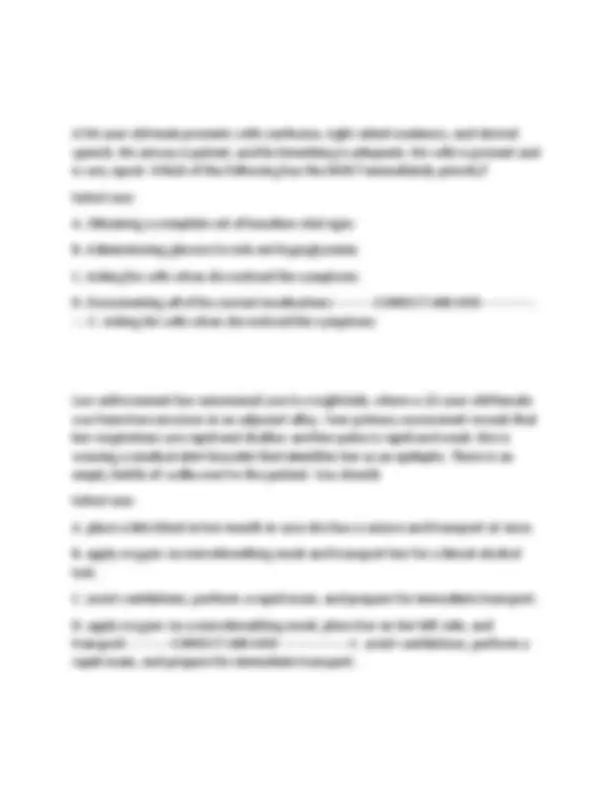
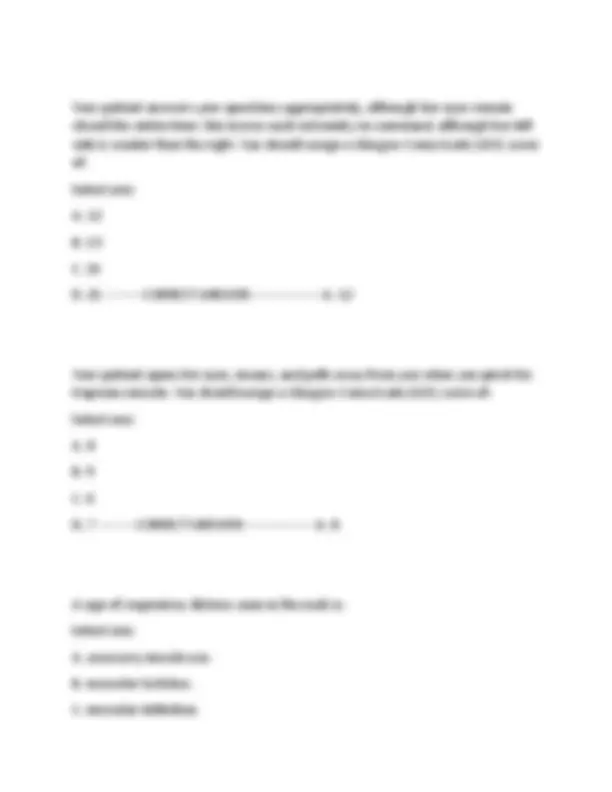
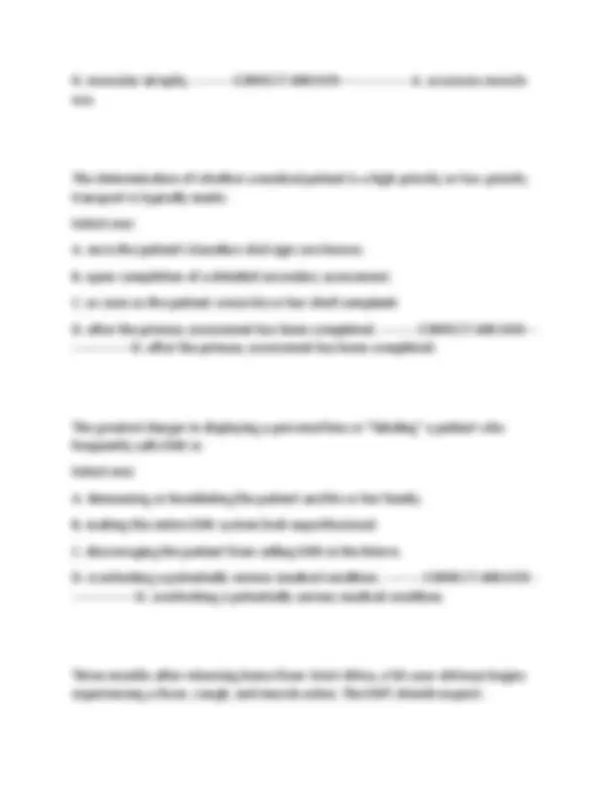
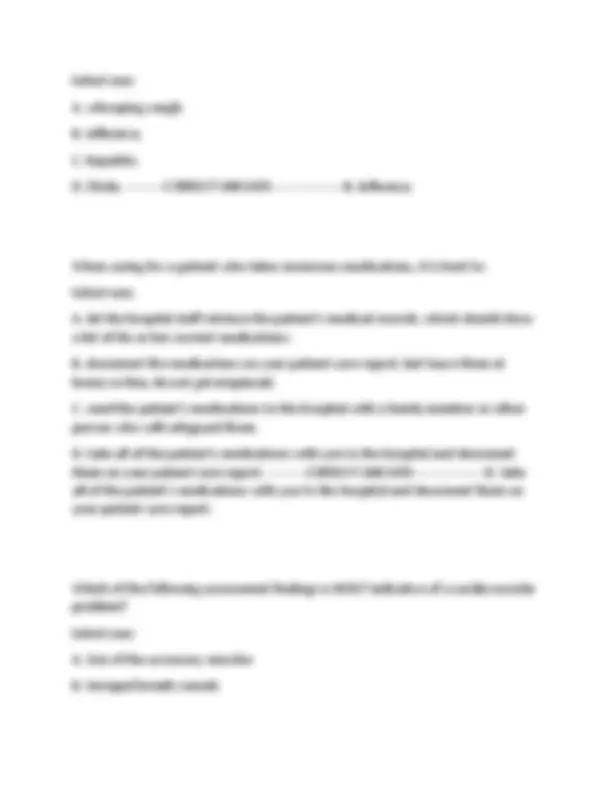
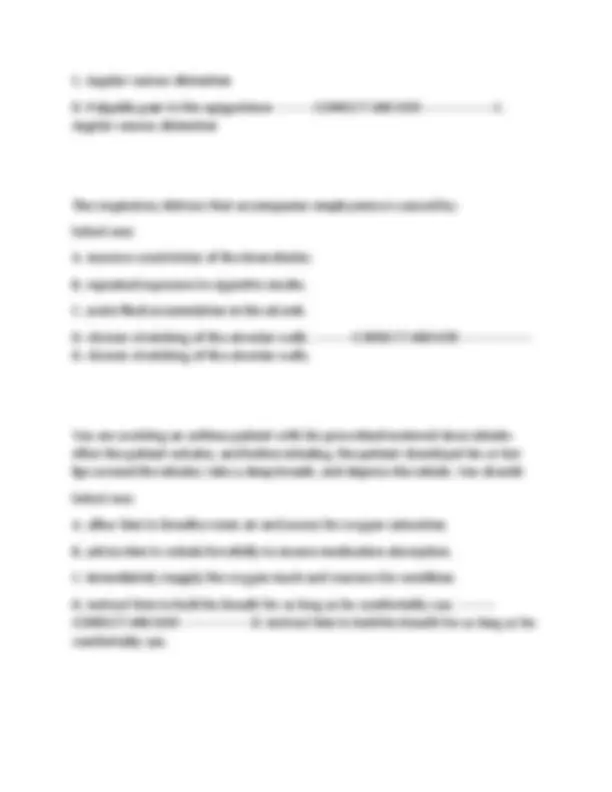
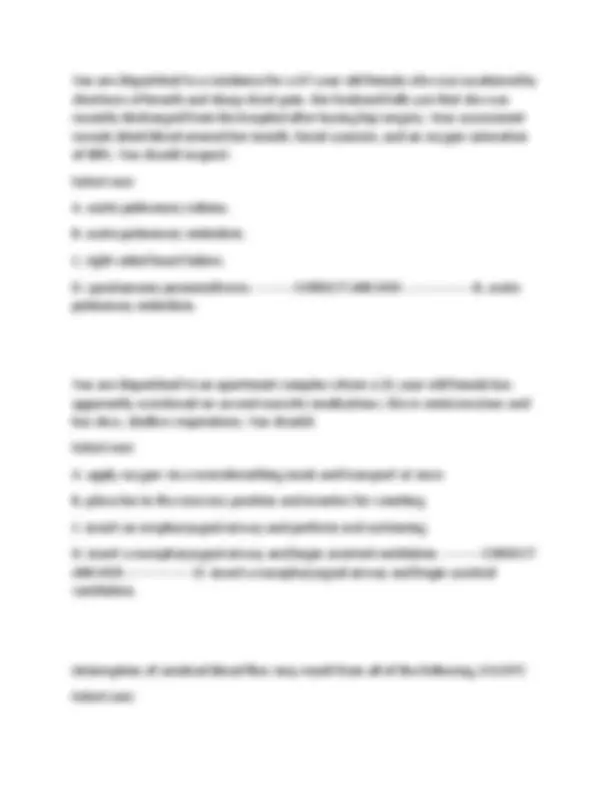
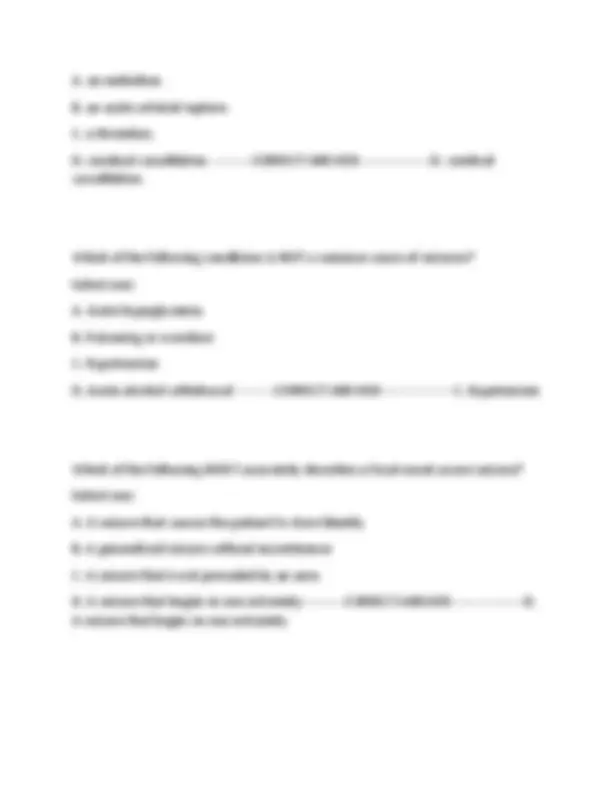
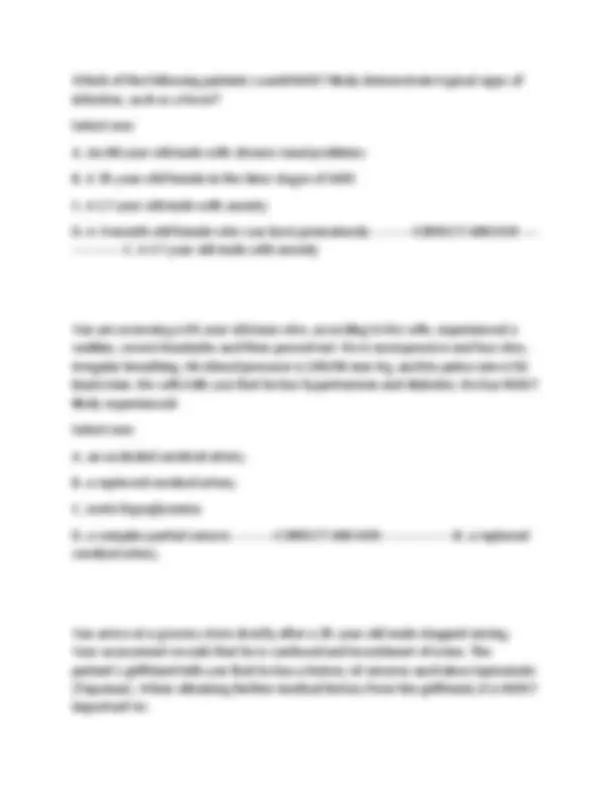
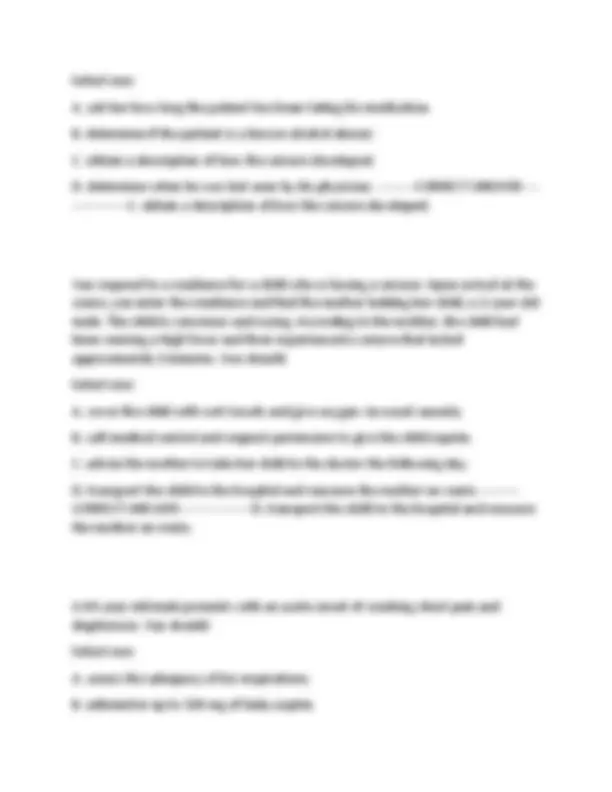
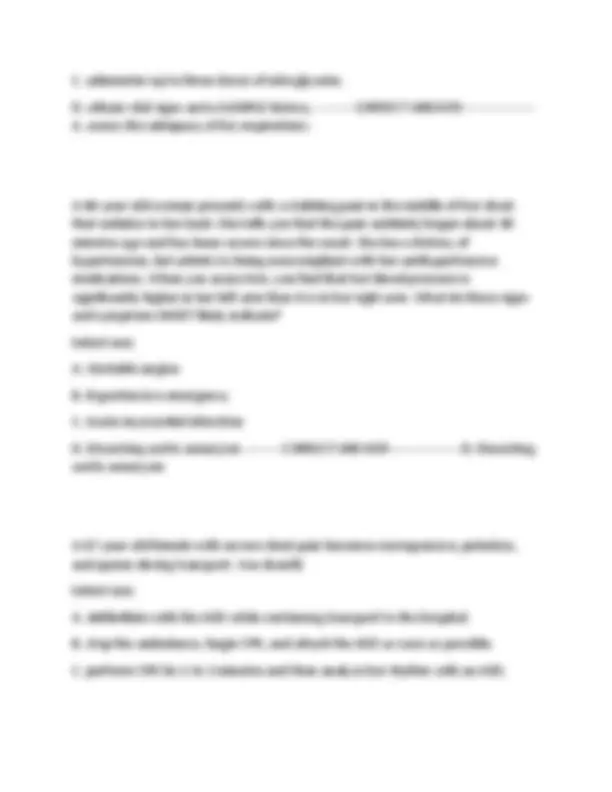
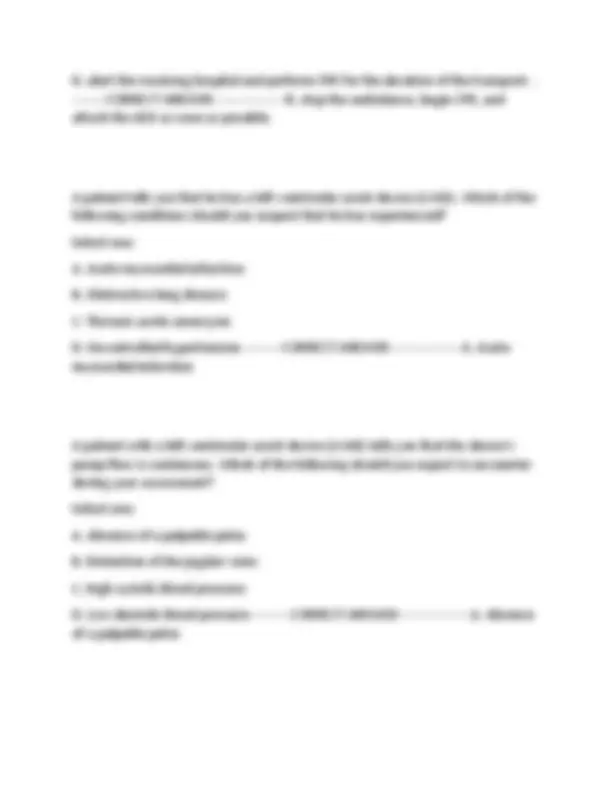
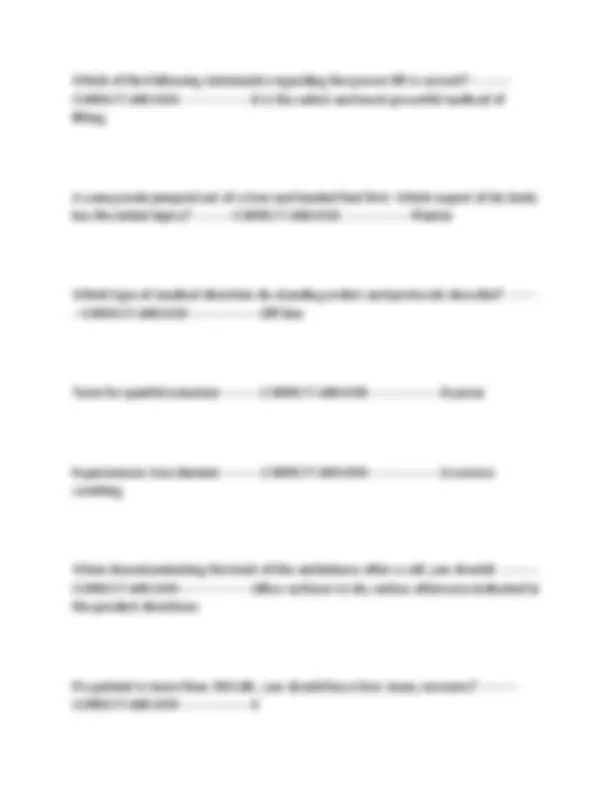
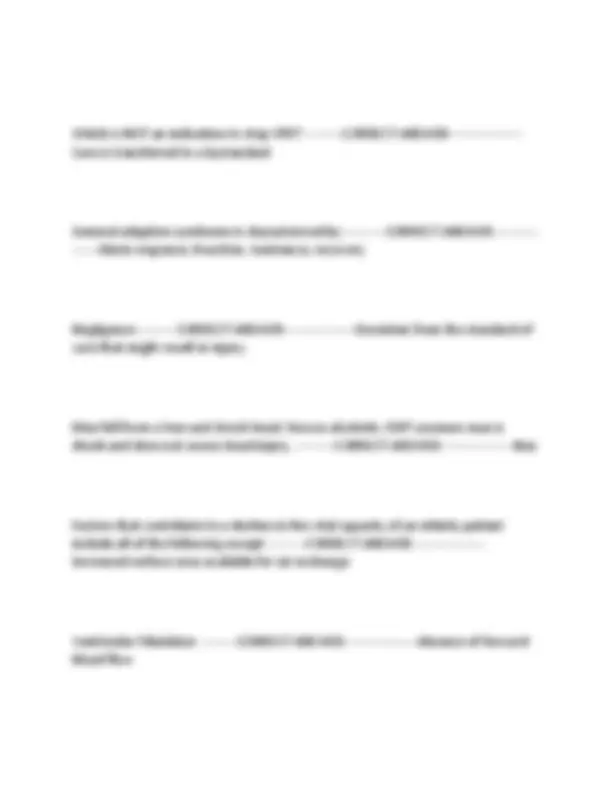
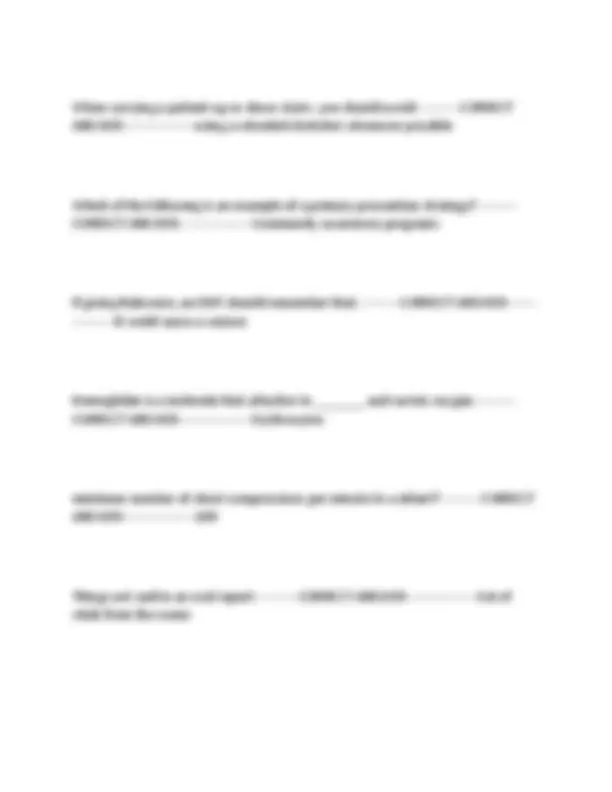
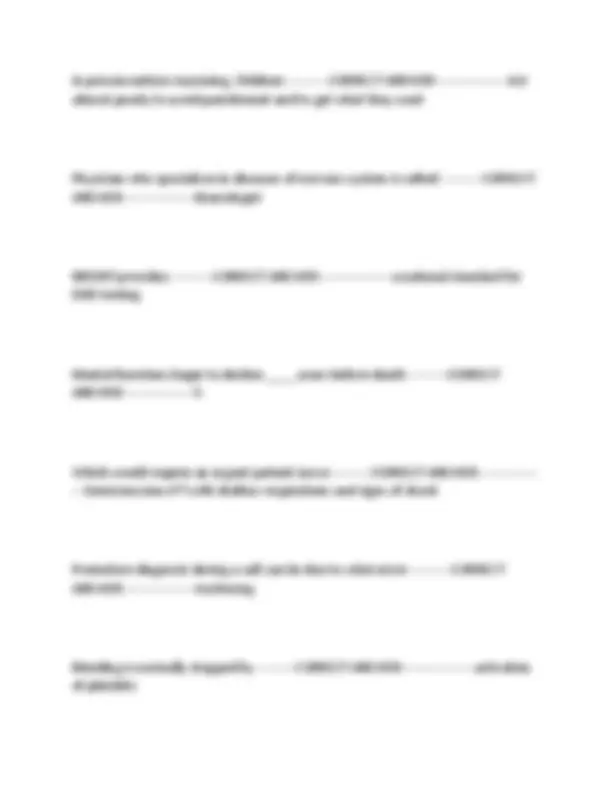
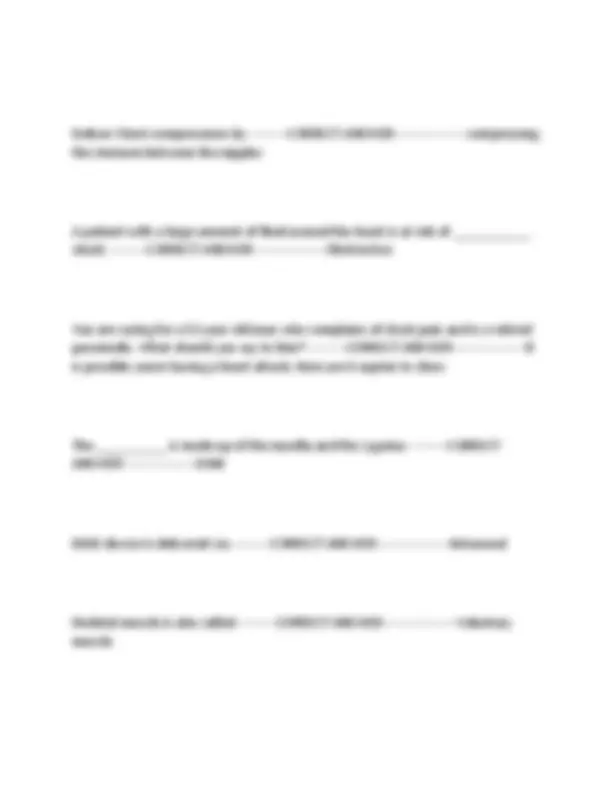
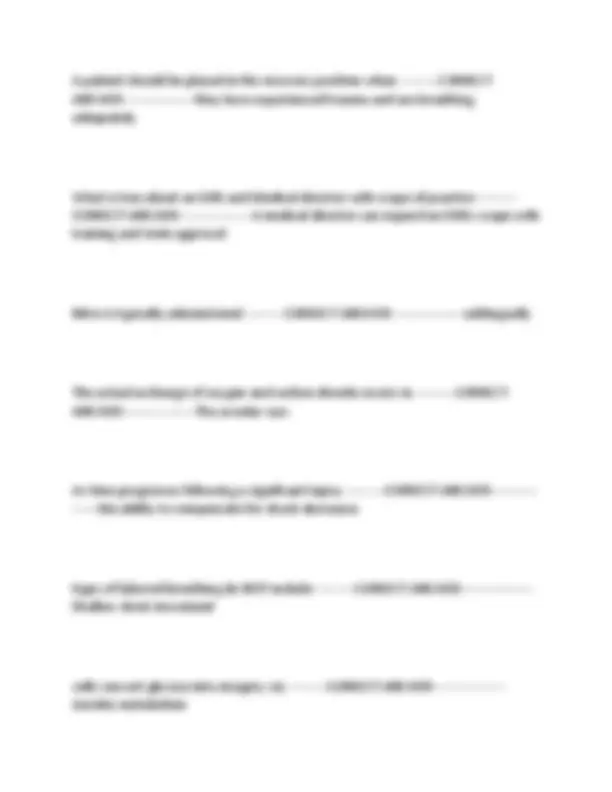
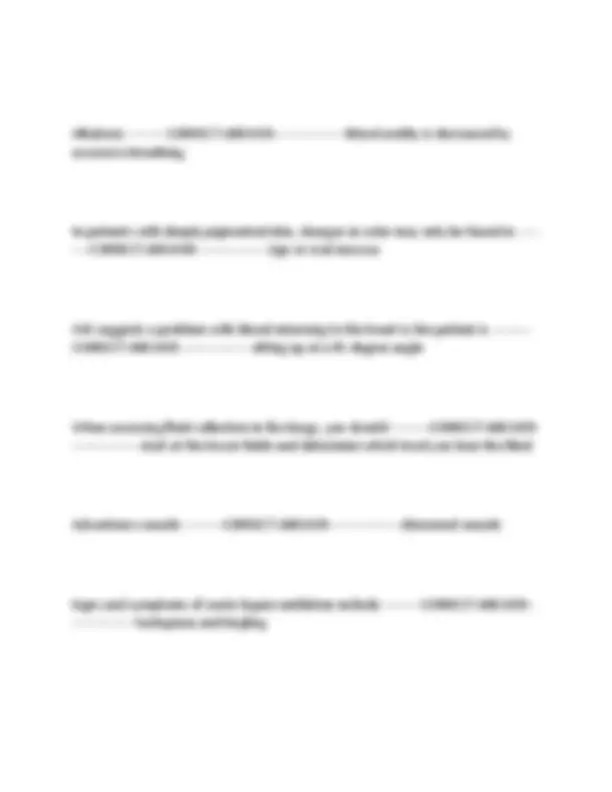
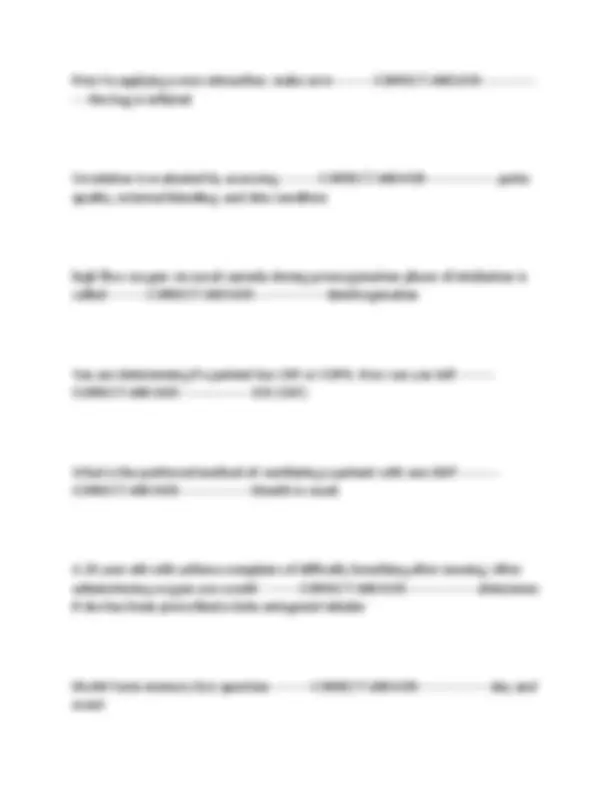
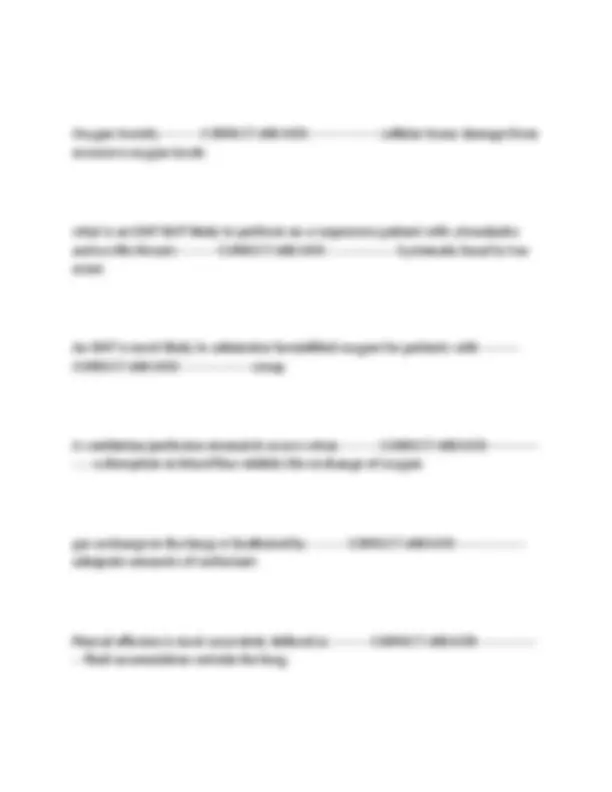
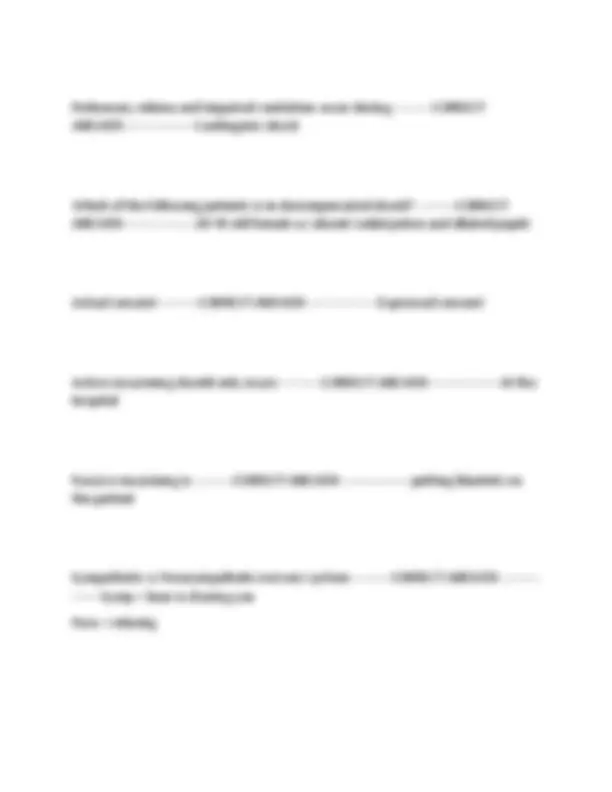
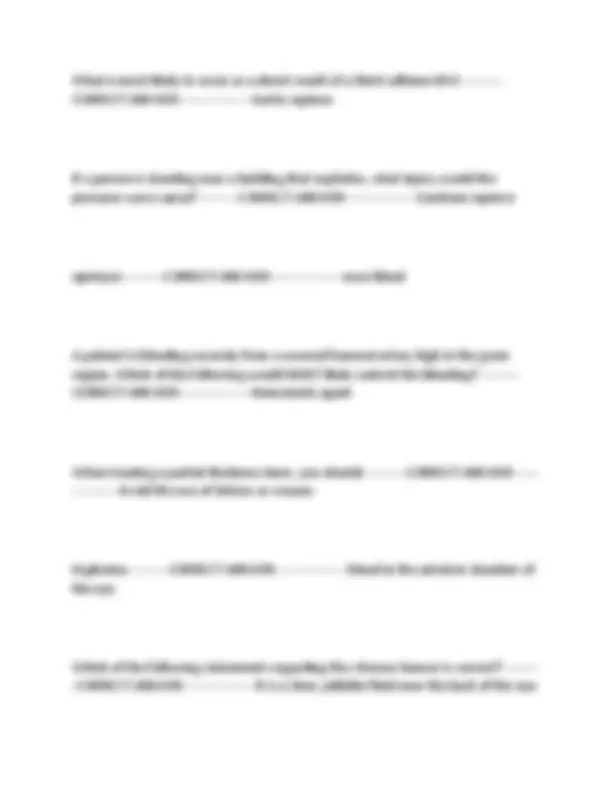
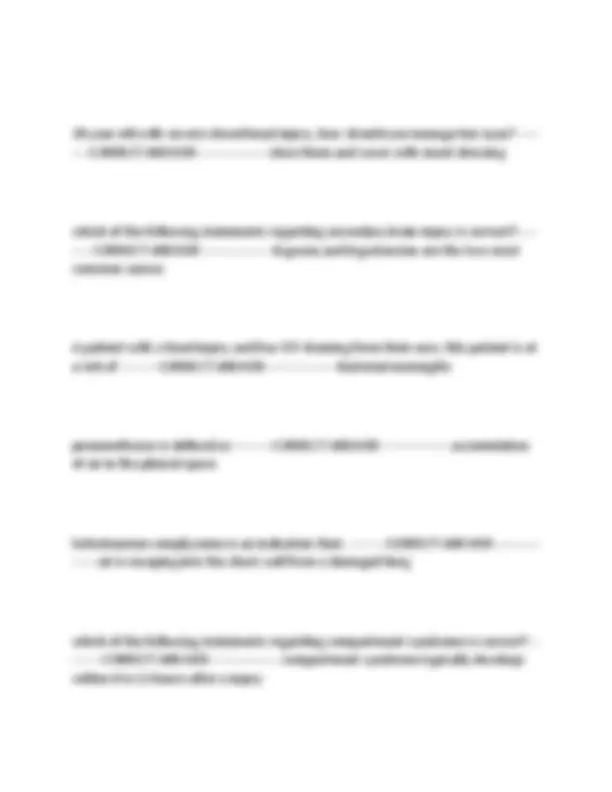
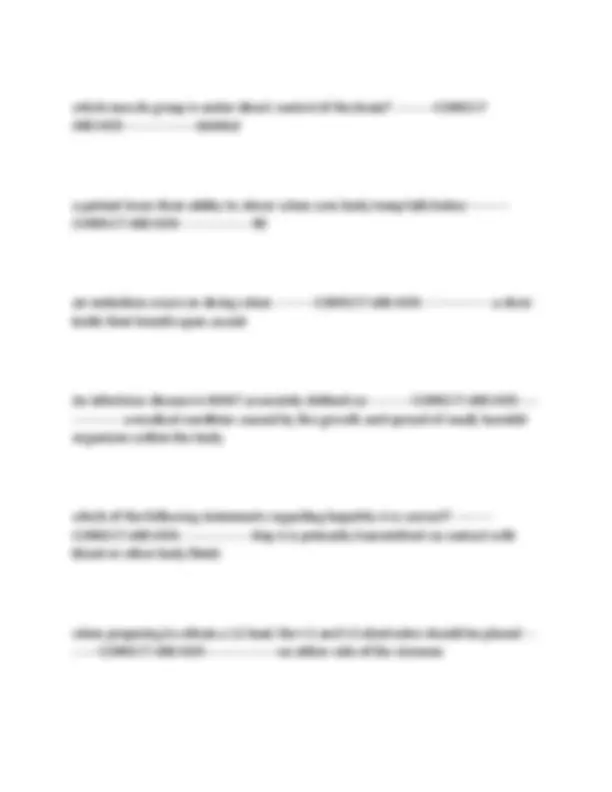
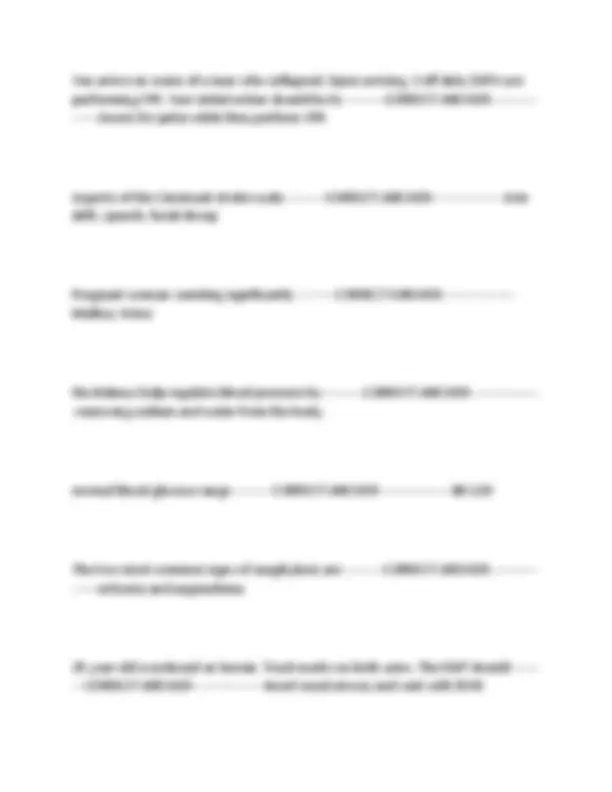
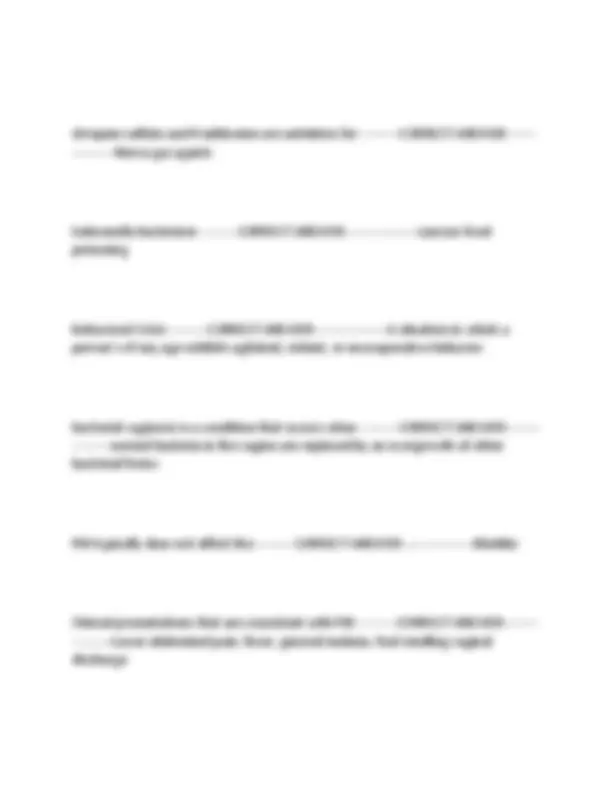
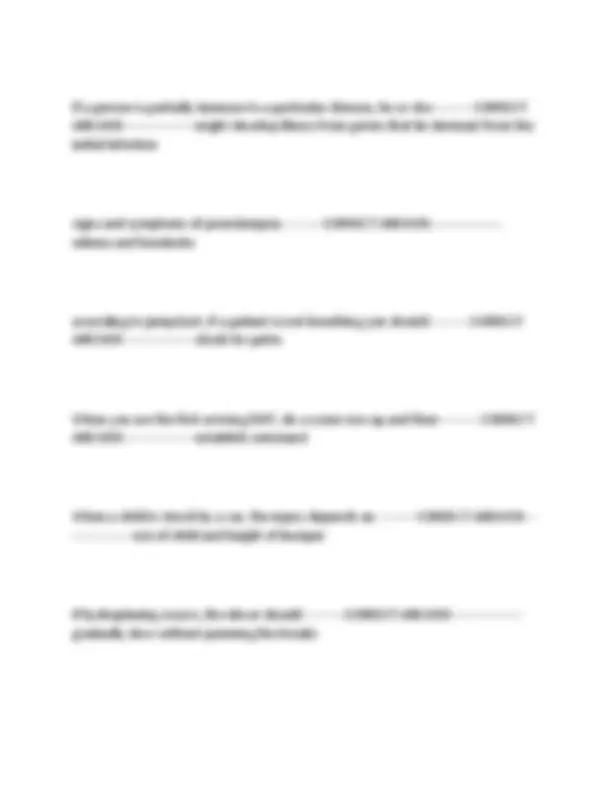
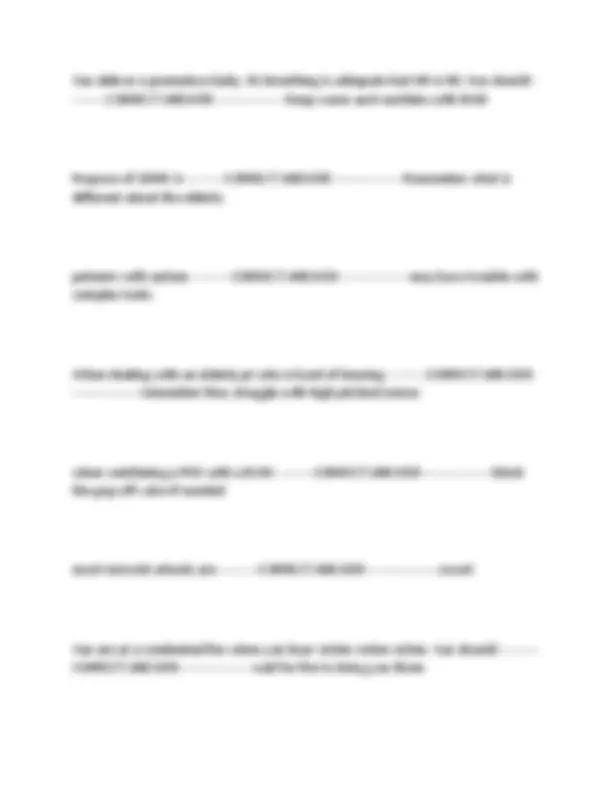
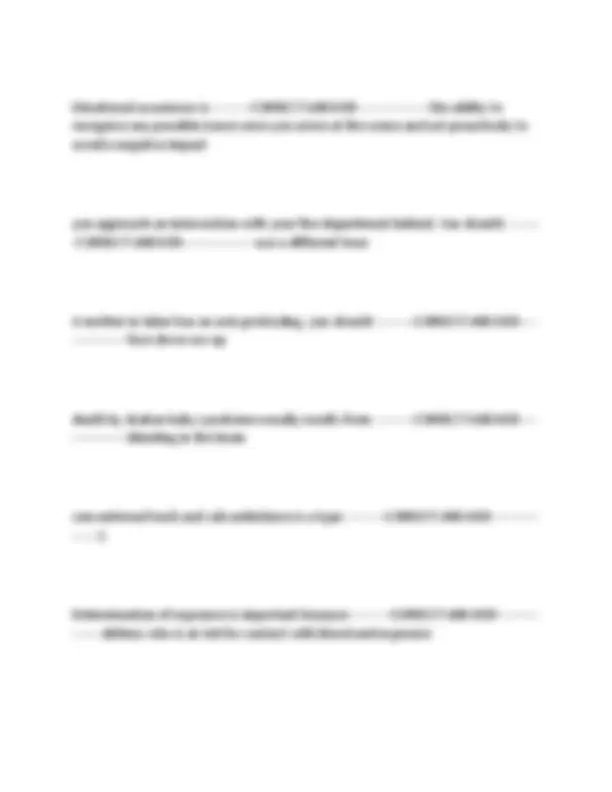
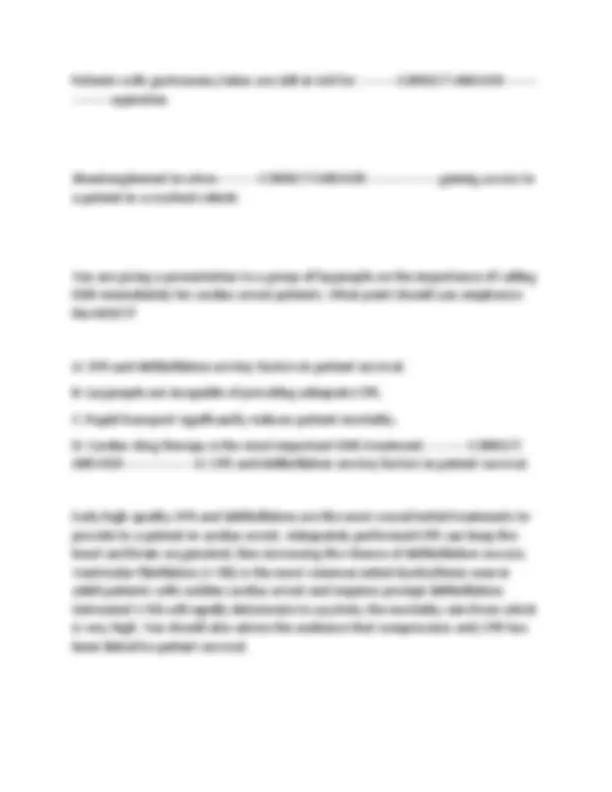
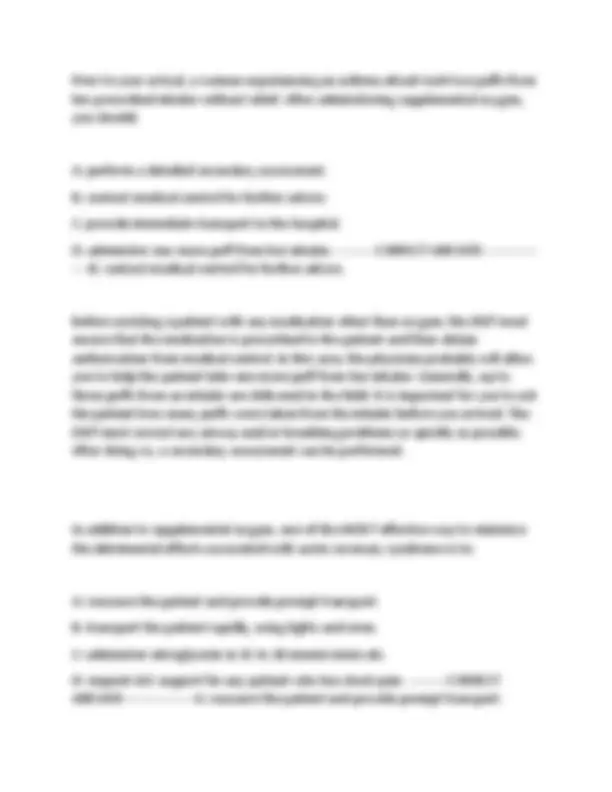
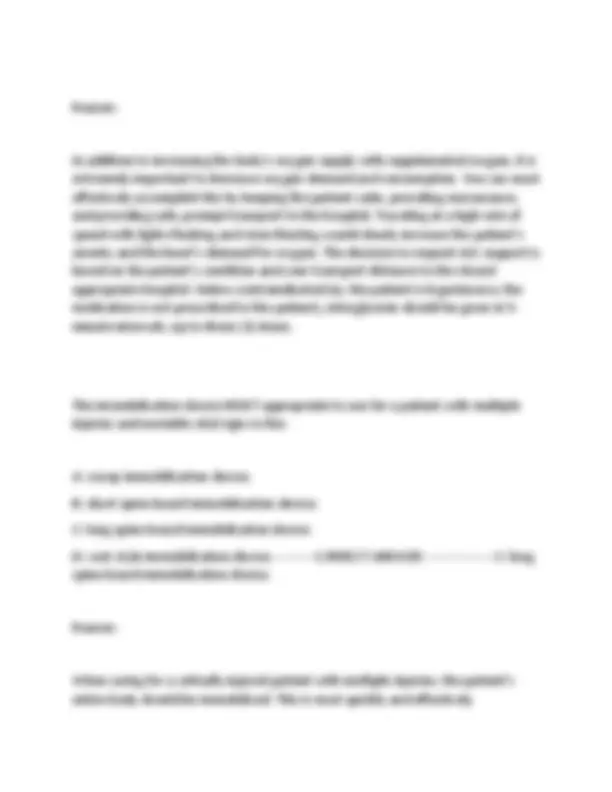
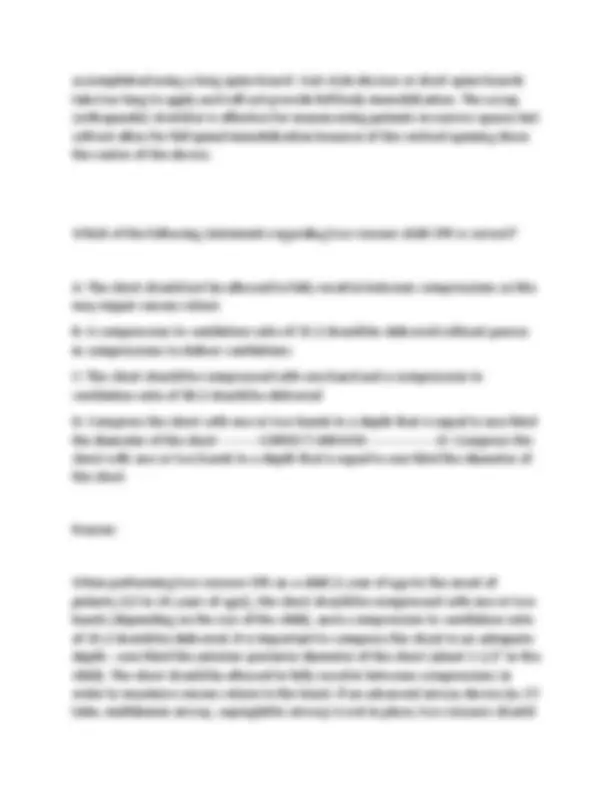
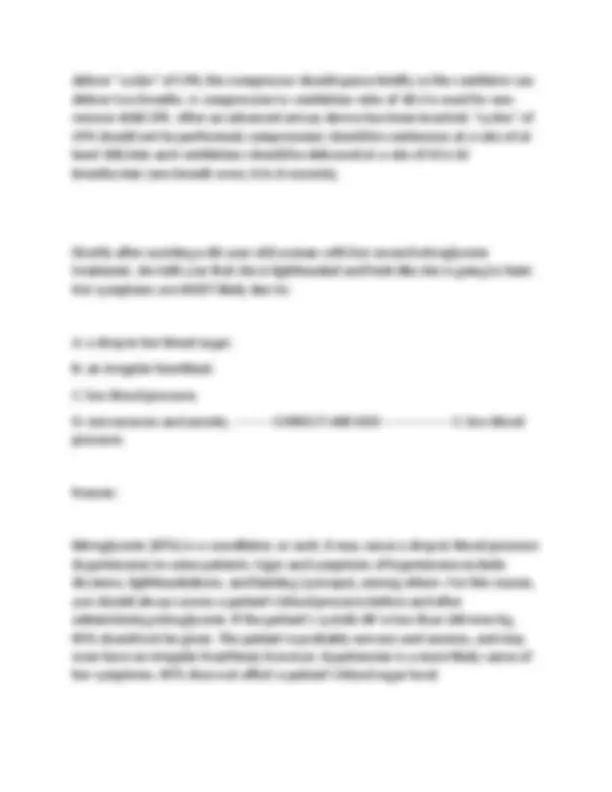
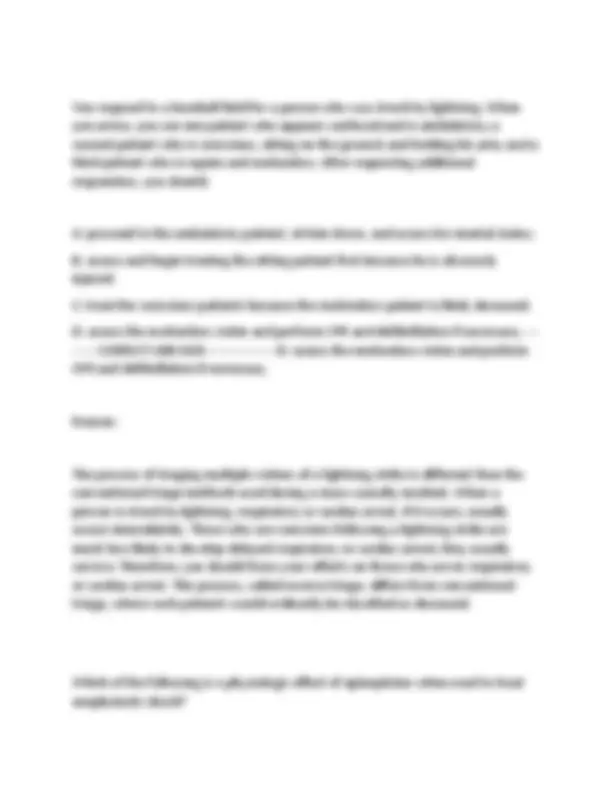
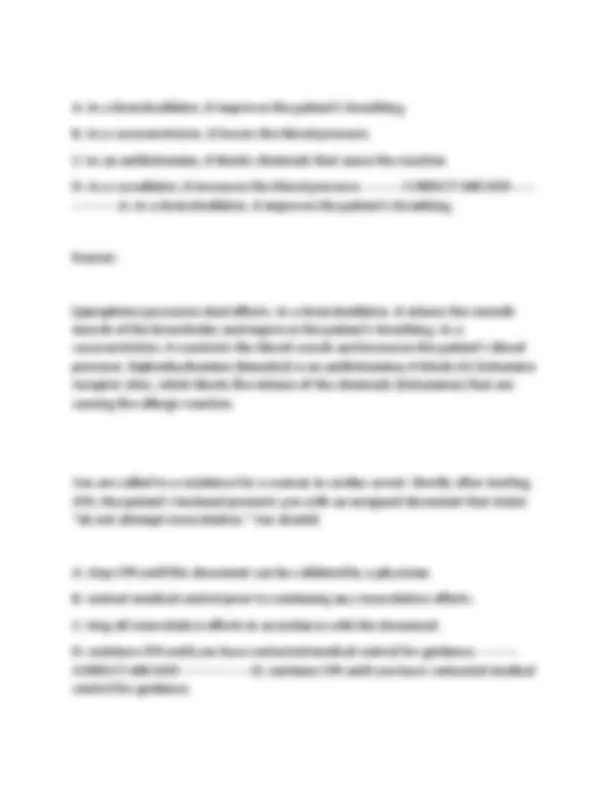
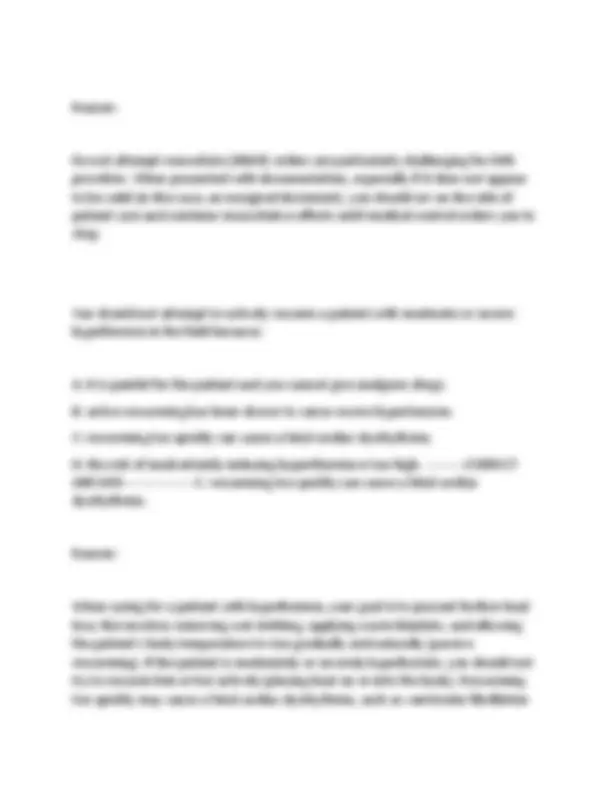
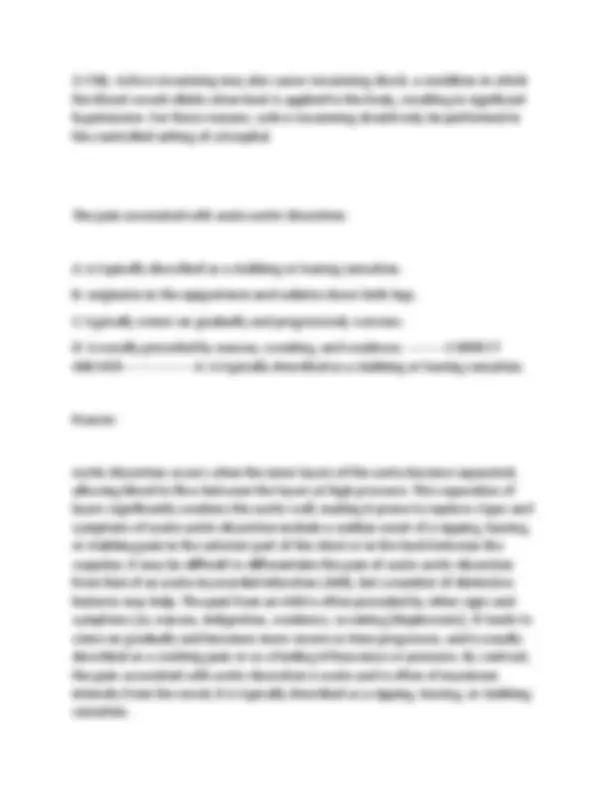
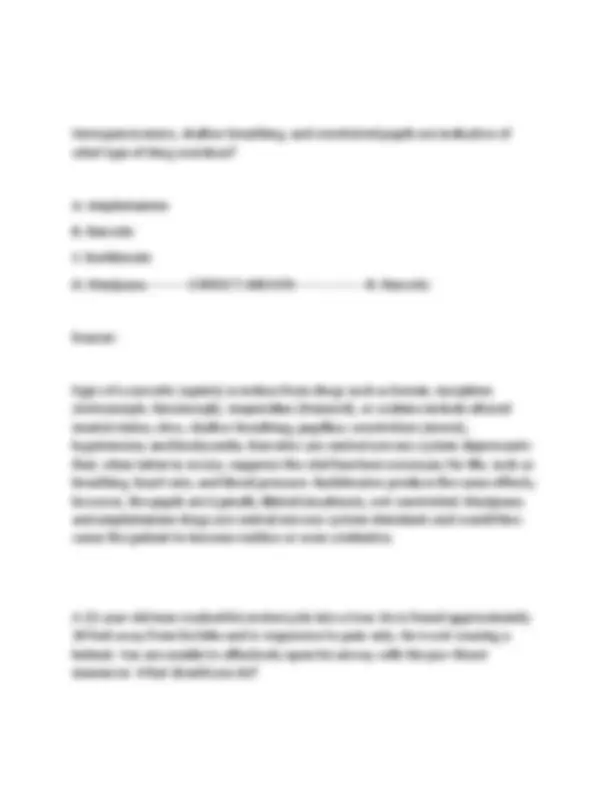
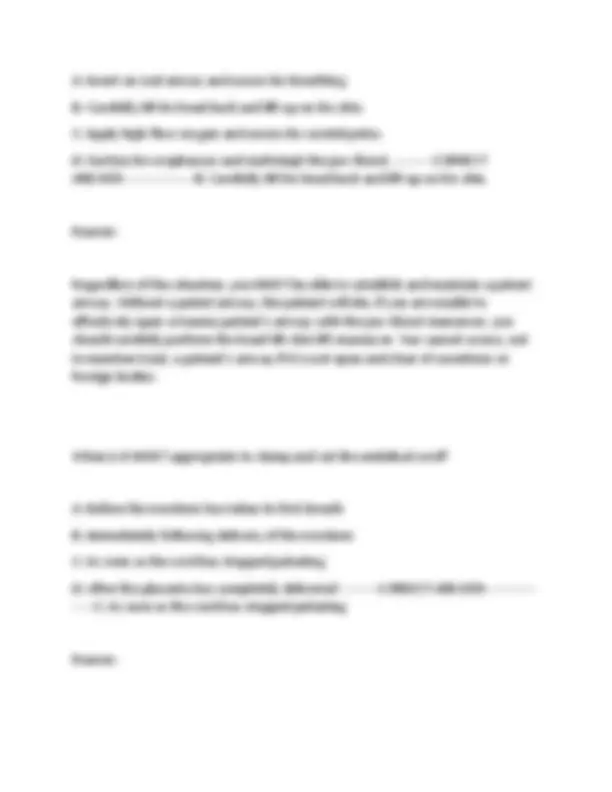
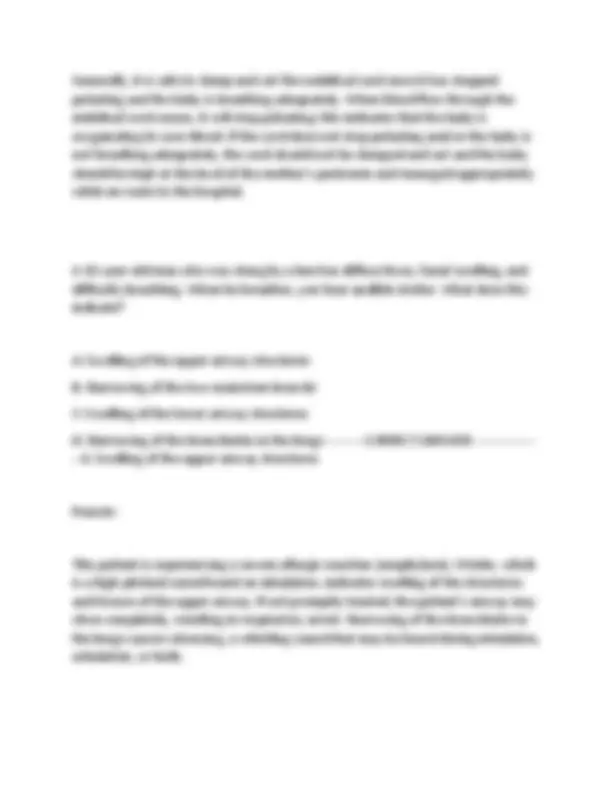
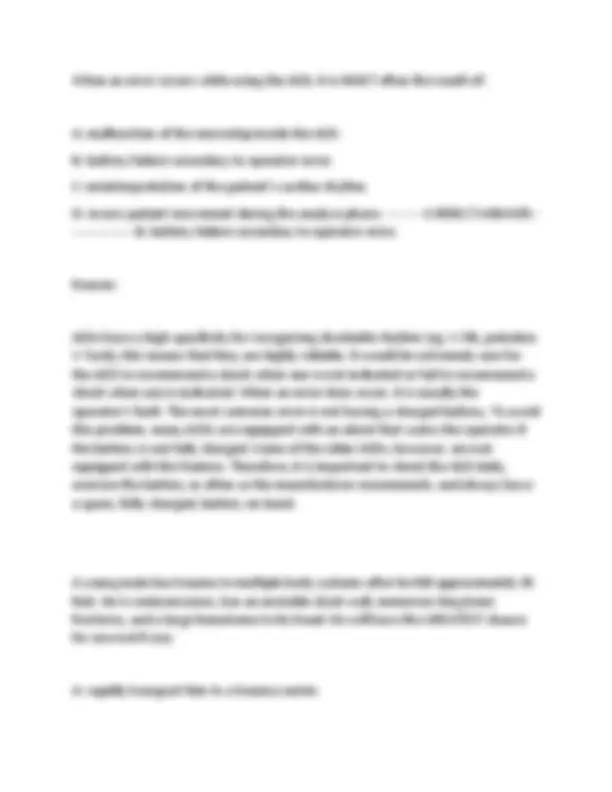
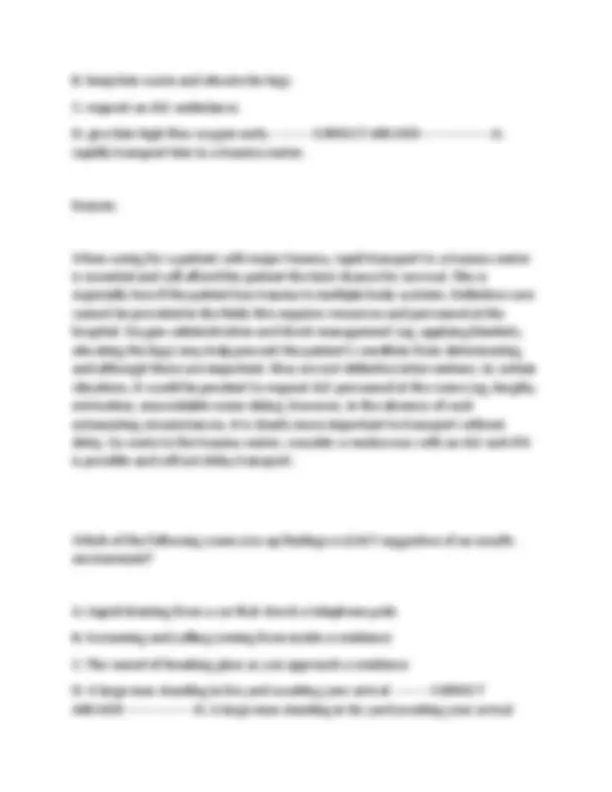


Study with the several resources on Docsity

Earn points by helping other students or get them with a premium plan


Prepare for your exams
Study with the several resources on Docsity

Earn points to download
Earn points by helping other students or get them with a premium plan
Community
Ask the community for help and clear up your study doubts
Discover the best universities in your country according to Docsity users
Free resources
Download our free guides on studying techniques, anxiety management strategies, and thesis advice from Docsity tutors
JBL EMT Final Exam Newest Exam 2025 | Updated Questions and Correct Answers | Verified Answers | Just Released
Typology: Exams
1 / 287

This page cannot be seen from the preview
Don't miss anything!





























































































You are dispatched to an apartment complex to respond to a shooting. Law enforcement personnel are present and have the suspect in custody. You find the patient lying in a narrow space between the couch and coffee table of his small apartment. He is semiconscious and has a large gunshot wound to his chest. You should: Select one: A. drag the patient into a larger area so that you can begin treatment. B. obtain permission from law enforcement before moving anything. C. treat the patient where he is so that you do not destroy any evidence. D. quickly move the coffee table so you can access and treat the patient. --------- CORRECT ANSWER-----------------D. quickly move the coffee table so you can access and treat the patient. Which organ lies in the lateral and posterior portion of the left upper quadrant of the abdomen? Select one: A. Spleen B. Stomach C. Liver D. Cecum ---------CORRECT ANSWER-----------------A. Spleen
The major artery that supplies all other arteries with blood is the: Select one: A. carotid. B. brachial. C. femoral. D. aorta. ---------CORRECT ANSWER-----------------D. aorta. You and your partner enter the residence of an elderly couple, both of whom are found unconscious in their bed. There is no evidence of trauma. As you begin your assessment, you and your partner notice the smell of natural gas in the residence. Which of the following should be your most appropriate action? Select one: A. Rapidly remove the patients from their residence using a blanket or clothes drag. B. Perform a rapid assessment and then move the patients from their residence. C. Request another ambulance to assist with lifting and moving the patients. D. Quickly exit the residence and request the fire department to move the patients. ---------CORRECT ANSWER-----------------A. Rapidly remove the patients from their residence using a blanket or clothes drag. Why are prehospital emergency care guidelines updated on a regular basis? Select one:
B. Medial C. Bidirectional D. Unilateral ---------CORRECT ANSWER-----------------D. Unilateral Mean arterial pressure (MAP) is a product of: Select one: A. stroke volume and systemic vascular resistance. B. heart rate and systemic vascular resistance. C. heart rate and stroke volume. D. cardiac output and systemic vascular resistance. ---------CORRECT ANSWER------- ----------D. cardiac output and systemic vascular resistance. While transporting a stable patient with chest pain to the hospital, you come across a major motor vehicle crash involving several critically injured patients. You should: Select one: A. remain at the scene until law enforcement and another ambulance arrive. B. continue transporting your patient and notify the dispatcher of the crash. C. ask a bystander to remain with your patient as you treat the crash victims. D. stop and triage the patients while your partner remains in the ambulance. ------ ---CORRECT ANSWER-----------------B. continue transporting your patient and notify the dispatcher of the crash.
After assuming care of a cardiac arrest patient from an EMT, the paramedic should remember that: Select one: A. ALS interventions are fundamentally more critical than BLS interventions. B. BLS efforts must continue throughout the patient care continuum. C. the BLS care provided by the EMT is the "first steps" of ALS care. D. ALS interventions are the core interventions around which BLS care is provided. ---------CORRECT ANSWER-----------------B. BLS efforts must continue throughout the patient care continuum. Your EMS system uses a computerized PCR in which you fill in the information electronically and then send it to the emergency department via a secure Internet server. The PCR has a comprehensive series of drop-down boxes, which are used to identify your assessment findings and specify the treatment that you provided; it also has a section for your narrative. When completing your PCR after a call, you should: Select one: A. avoid documenting personally identifiable information, such as the patient's name, because the PCR could be intercepted during transmission. B. complete a thorough and accurate narrative because drop-down boxes cannot provide all of the information that needs to be documented. C. enter all of the pertinent information of the electronic PCR, but then print it out and provide a copy to the emergency department staff. D. defer the narrative only if the information in the drop-down boxes accurately ref ---------CORRECT ANSWER-----------------B. complete a thorough and accurate narrative because drop-down boxes cannot provide all of the information that needs to be documented.
C. An infant's heart rate decreases secondary to hypoxia because he or she depends heavily on the heart rate to perfuse the body. D. When the sole of the foot is stroked with a blunt object, the big toe lifts upward and the other toes fan outward. ---------CORRECT ANSWER-----------------A. The neonate opens his or her arms wide, spreads his or her fingers, and seems to grasp at something after being startled. Shortly after you load your patient, a 50-year-old man with abdominal pain, into the ambulance, he tells you that he changed his mind and does not want to go to the hospital. The patient is conscious and alert and has no signs of mental incapacitation. You are suspicious that the man has a significant underlying condition and feel strongly that he should go to the hospital. Which of the following statements regarding this situation is correct? Select one: A. Once the patient is in the ambulance, he cannot legally refuse EMS treatment. B. Any patient who refuses EMS treatment must legally sign a patient refusal form. C. Because of your suspicions, the best approach is to transport him to the hospital. D. A mentally competent adult can withdraw his or her consent to treat at any time. ---------CORRECT ANSWER-----------------D. A mentally competent adult can withdraw his or her consent to treat at any time. As an EMT, you may be authorized to administer aspirin to a patient with chest pain based on: Select one: A. the transport time to the hospital.
B. medical director approval. C. an order from a paramedic. D. the patient's condition. ---------CORRECT ANSWER-----------------B. medical director approval. EMT training in nearly every state meets or exceeds the guidelines recommended by the: Select one: A. National Highway Traffic Safety Administration (NHTSA). B. National Registry of EMTs. C. individual state's EMS protocols. D. National Association of EMTs. ---------CORRECT ANSWER-----------------A. National Highway Traffic Safety Administration (NHTSA). Which of the following statements regarding the EMS medical director and an EMT's scope of practice is correct? Select one: A. The EMS medical director can expand the EMT's scope of practice but cannot limit it without state approval. B. The EMS medical director can expand or limit an individual EMT's scope of practice without state approval. C. An EMT's scope of practice may be expanded by the medical director after proper training and state approval. D. An EMT's scope of practice is exclusively regulated by the state EMS office, not the EMS medical director. ---------CORRECT ANSWER-----------------C. An EMT's
Physiologic manifestations of stress include: Select one: A. increased blood pressure, decreased blood glucose levels, and chest pain. B. perspiration, increased blood glucose levels, and dilated pupils. C. flushed skin, decreased muscle control, and vomiting. D. slow heart rate, low blood pressure, and severe headaches. ---------CORRECT ANSWER-----------------B. perspiration, increased blood glucose levels, and dilated pupils. Which of the following scenarios most accurately depicts a posttraumatic stress disorder (PTSD) reaction? Select one: A. A newly certified EMT becomes extremely nauseated and diaphoretic at the scene of an incident involving grotesque injuries. B. An EMT becomes distracted at the scene of a motor vehicle crash involving the same type of car in which a child was previously killed. C. An EMT with many years of field experience becomes irritable with her coworkers and experiences headaches and insomnia. D. An EMT is emotionally exhausted and depressed after a school bus crash involving critical injuries and the death of several children. ---------CORRECT ANSWER-----------------B. An EMT becomes distracted at the scene of a motor vehicle crash involving the same type of car in which a child was previously killed. Which of the following statements regarding the hepatitis B vaccine is correct? Select one:
A. Vaccination against hepatitis B provides partial immunity for life. B. The hepatitis B vaccine provides protection against the disease for two years. C. Vaccination with the hepatitis B vaccine confers immunity against hepatitis A. D. OSHA requires that your employer offer you the vaccine free of charge. --------- CORRECT ANSWER-----------------D. OSHA requires that your employer offer you the vaccine free of charge. Which of the following statements would not be appropriate to say to the family of a dying patient? Select one: A. "Tell me how you are feeling." B. "This must be painful for you." C. "Things will get better in time." D. "It is okay to be angry and sad." ---------CORRECT ANSWER-----------------C. "Things will get better in time." You are caring for a 40-year-old female who was involved in a motor vehicle crash. Her husband, who was driving the vehicle, was killed. When the patient asks you if her husband is all right, you should: Select one: A. avoid answering her questions and focus on her injuries. B. let clergy or hospital staff relay the bad news if possible. C. tell her that he is being resuscitated by other EMTs.
Select one: A. A call is received 15 minutes prior to shift change. B. The EMT hears of a cardiac arrest after his or her shift ends. C. A bystander encounters a victim who is not breathing. D. The EMT witnesses a vehicle crash while off duty. ---------CORRECT ANSWER----- ------------A. A call is received 15 minutes prior to shift change. Your best protection against legal liability when a patient with decision-making capacity refuses EMS care and transport is to: Select one: A. err on the side of caution and transport. B. ensure that the family is aware of the risks. C. thoroughly document the entire event. D. advise medical control of the situation. ---------CORRECT ANSWER----------------- C. thoroughly document the entire event. After delivering your patient to the hospital, you sit down to complete the handwritten PCR. When documenting the patient's last blood pressure reading, you inadvertently write 120/60 instead of 130/70. To correct this mistake, you should: Select one: A. cover the error with correction fluid and then write the patient's actual blood pressure over it. B. erase the error, initial it, and then write the correct data on a separate addendum.
C. leave the error on the PCR, but inform the staff of the patient's actual blood pressure. D. draw a single horizontal line through the error, initial it, and write the correct data next to it. ---------CORRECT ANSWER-----------------D. draw a single horizontal line through the error, initial it, and write the correct data next to it. During your assessment of a 20-year-old man with a severe headache and nausea, you ask him when his headache began, but he does not answer your question immediately. You should: Select one: A. repeat your question because he probably did not hear you. B. ask him if he frequently experiences severe headaches and nausea. C. allow him time to think about the question and respond to it. D. tell him that you cannot help him unless he answers your questions. --------- CORRECT ANSWER-----------------C. allow him time to think about the question and respond to it. The official transfer of patient care does not occur until the EMT: Select one: A. gives a radio report to the receiving medical facility. B. notifies the admitting clerk of the patient's arrival at the hospital. C. informs dispatch of the patient's arrival at the emergency department. D. gives an oral report to the emergency room physician or nurse. --------- CORRECT ANSWER-----------------D. gives an oral report to the emergency room physician or nurse.
A 16-year-old female complains of vaginal bleeding and abdominal cramping that began several hours ago. During your assessment interview, you should: Select one: A. obtain the majority of your information from one of her parents. B. inquire about the possibility of pregnancy in private, if possible. C. avoid asking questions that she will feel uncomfortable answering. D. recall that patients in this age group prefer not to be treated as adults. --------- CORRECT ANSWER-----------------B. inquire about the possibility of pregnancy in private, if possible. The low normal systolic blood pressure for a 30-year-old is: Select one: A. 80 mm Hg. B. 70 mm Hg. C. 60 mm Hg. D. 90 mm Hg. ---------CORRECT ANSWER-----------------D. 90 mm Hg. The risk of bleeding in the skull, which increases with age, is most directly related to: Select one: A. a decrease in neurons. B. shrinkage of the brain. C. blood vessel dilation.
D. meningeal deterioration. ---------CORRECT ANSWER-----------------B. shrinkage of the brain. An 81-year-old female fell and struck her head. You find the patient lying on her left side. She is conscious and complains of neck and upper back pain. As you are assessing her, you note that she has a severely kyphotic spine. What is the most appropriate method of immobilizing this patient? Select one: A. Apply a cervical collar and place her in a sitting position on the wheeled stretcher. B. Immobilize her in a supine position on a long backboard and secure her with straps. C. Move her to a supine position and immobilize her with a scoop stretcher and padding. D. Leave her on her side and use blanket rolls to immobilize her to the long backboard. ---------CORRECT ANSWER-----------------D. Leave her on her side and use blanket rolls to immobilize her to the long backboard. In most instances, you should move a patient on a wheeled ambulance stretcher by: Select one: A. pushing the foot of the stretcher while your partner guides the head. B. pushing the head of the stretcher while your partner guides the foot. C. retracting the undercarriage and carrying the stretcher to the ambulance.
When pulling a patient, you should extend your arms no more than ________ in front of your torso. Select one: A. 10″ to 15″ B. 20″ to 30″ C. 5″ to 10″ D. 15″ to 20″ ---------CORRECT ANSWER-----------------D. 15″ to 20″ Health care teams that infrequently train and work together: Select one: A. need less-explicit verbal direction. B. are unable to accomplish their tasks. C. often work better under pressure. D. can create delays in patient care. ---------CORRECT ANSWER-----------------D. can create delays in patient care. Which of the following is an example of closed-loop communication? Select one: A. The team leader assigns the EMT a task, and the EMT repeats the request back to the team leader. B. The EMT corrects the team leader, who states that chest compressions should be greater than 3 inches deep. C. The EMT requests permission from medical control to assist a patient with his prescribed nitroglycerin.
D. EMTs decide not to attempt resuscitation because the patient has rigor mortis and is cold to the touch. ---------CORRECT ANSWER-----------------A. The team leader assigns the EMT a task, and the EMT repeats the request back to the team leader. ___________ pressure is the pressure exerted by a liquid that occurs when blood moves through an artery at relatively high pressures. Select one: A. Oncotic B. Osmotic C. Diffusion D. Hydrostatic ---------CORRECT ANSWER-----------------D. Hydrostatic Activities such as walking, talking, and writing are regulated by the: Select one: A. central nervous system. B. somatic nervous system. C. involuntary nervous system. D. autonomic nervous system. ---------CORRECT ANSWER-----------------B. somatic nervous system. An increase in heart rate and contractility occurs due to stimulation of: Select one: A. beta-2 receptors.